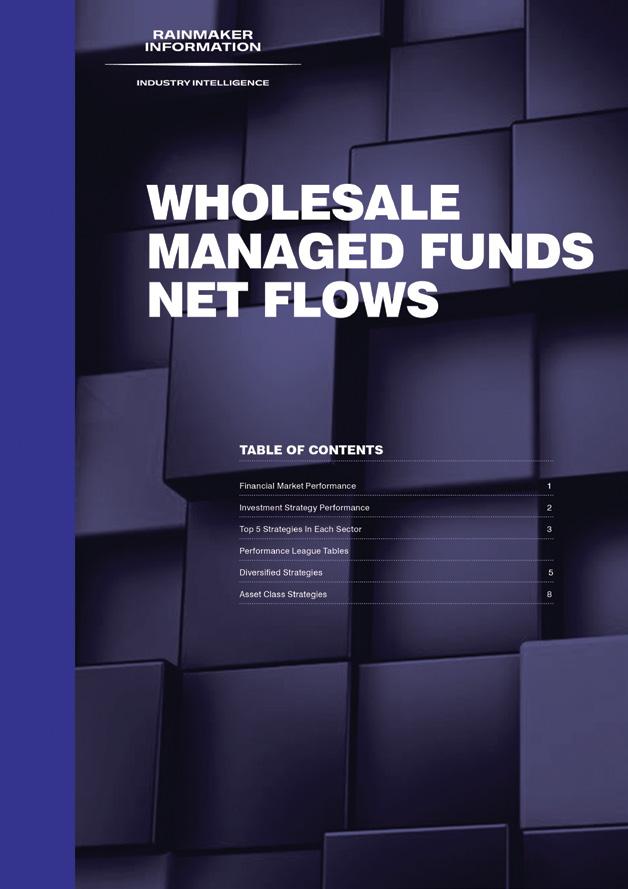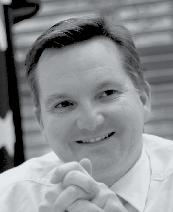Industry grapples with looming cyber threats
Chloe Walker
With the threat of cyber-attacks growing by the day, leadership teams in all areas of financial services are being urged to ramp up cybersecurity protections, with the regulators keeping a keen eye on their efforts. But while major institutions might be well resourced to respond, financial advisers are falling behind.
In recent months, several major institutions have fallen victim to cyber breaches, most notably NGS Super.
According to MinterEllison’s 2023 Cyber Risk Report , 82% of survey respondents from the financial services sector ranked cyber risk among their top five priorities. However, only half of respondents (across all sectors) believed their organisation had sufficient resources to monitor and respond to its cybersecurity needs.
MinterEllison technology and data partner Paul Kallenbach says the last 12 months have seen a significant increase in the sophistication and frequency of cyber-attacks.
“In general terms, I do believe that Australian financial services organisations are focused on preparing for future cyber-attacks,” Kallenbach says.
This is driven, in part, by layers of cyber-related regulation, including the Privacy Act, the Corporations Act, and the Security of Critical Infrastructure Act.
Moreover, with the recent large scale data breaches in Australia, Kallenbach says the sector is understandably very nervous about, and therefore focused on mitigating, this risk.
Regulators are also focused on it. In June, ASIC launched a cyber pulse survey to measure cyber resilience, open to all ASIC-regulated entities for the first time. In a statement to Financial Standard , ASIC confirmed most respondents so far have opted in to receive an individual report, providing insight as to how their cyber resilience compares to their peers.
Meanwhile, APRA is assessing more than 300 of its regulated entities’ compliance with CPS 234 Information Security. So far, 24% of entities have been reviewed, finding several concerning gaps including incident response plans not being regularly reviewed or tested.
Bright Corporate Law principal David Jacobson says serious penalties and costs can apply to licensees who fail to protect confidential and sensitive personal information of clients.

Referencing the Federal Court judgement in
ASIC v RI Advice Group, in which RI Advice was found to have failed its cybersecurity obligations, Jacobson says regulatory expectations are ramping up.
“The proceedings against RI Advice are of interest because they show ASIC’s appetite to take enforcement action against companies that fail to meet reasonable standards in managing cyber risks,” he notes.
And APRA regulations are now designed to make sure that financial institutions know what data they have and test to ensure systems are as secure as possible, with a requirement to report serious data breaches to the Privacy Commissioner as well as affected individuals.
“Of course, there can always be human error. Therefore, on an organisational level, APRA requires the training of employees and education of customers to make sure financial institutions are as secure as they can be,” Jacobson says.
However, at the other end of town, The Cyber Collective founder Fraser Jack says financial advice practices are in dire need of support.
“The government is doing a very good job of combining resources and trying to come at this from a ‘one government’ point of view, but unfortunately smaller advice firms are falling through the cracks,” he says.
“Larger firms already have a lot of security in place, whereas it’s always been really difficult for the small ‘mum and dad’ businesses to hold fort because they don’t have all the cyber teams working for them.”
To prevent cyber-crime, Jack encourages advisers to look at three key areas of practice: technology, training, and testing.
“Firstly, setting the tech is an essential. Secondly, we look at training the teams, or what I call ‘rebooting the humans’, and the third area is being able to provide proof. For example, undertaking an audit or being able to demonstrate competence,” he says.
Jack also reminds practice owners to consider supply chain risks with third-party providers; ask the right questions and don’t just assume they have adequate processes in place.
He adds that having a strong cybersecurity plan in place not only strengthens a business but can improve client relationships, saying: “There’s a huge opportunity for advisers to have proactive conversations with their clients about their cybersecurity processes.” fs
Product showcase: Vincent Stranges, Generation Life 07
Executive appts: ART, Iress, Praemium 14
Feature: Managed accounts
BTL: Equity Trustees, MaxCap
Profile:
Bullock to be next RBA governor
Cassandra Baldini
Prime Minister Anthony Albanese and Treasurer Jim Chalmers announced Michele Bullock will take over as Reserve Bank of Australia (RBA) governor from Philip Lowe in September.
Chalmers said the government is proud to announce the ninth governor, confirming the appointment will be effective September 18.
In making the announcement, Albanese acknowledged Lowe’s seven-year service and thanked him for his tenure.
“We respect and appreciate the remarkable dedication and contribution he has made to our country and our economy, and the way he has conducted himself in a difficult role at a challenging time,” Chalmers said.
At the same time, he said Bullock is an accomplished economist with wide experience at the RBA, including her most recent role as deputy governor. In total, she has served close to 17 years with the central bank.
Her responsibilities at the RBA have included
Continued on page 4
Adviser demand rises: Recruiter
The financial advice industry is experiencing a buoyant jobs market in 2023, according to a specialist recruitment firm, particularly in the last three months which saw healthy demand for associate adviser roles.
Recruit2Advice principal Dugald Braithwaite said advisers and practices that are “well set in the market with a good reputation” are currently inundated with referrals and approaches from new clients.
“This suggests the value of advice is highly regarded in the Australian community and sought after, even with upward pricing pressures to deliver advice in recent years,” he said.
“We are seeing 50% in newly created roles, whilst the remainder are to replace advisers moving to self-employed or changing careers.”
In the last three months, Braithwaite has seen the market shift rapidly.
High demand is coming from the employers who want to re-adopt the associate adviser role,
Continued on page 4
Fraser Jack founder The Cyber Collective Australia
www.financialstandard.com.au 24 July 2023 | Volume 21 Number 14 24
32
13
Angus Whiteley, Stafford Capital Partners
05
Opinion: Andrew Baker, Ignition Advice
Change of the guard - maybe
Poor Reserve Bank of Australia (RBA) governor Philip Lowe has finally been put out of his misery.
This past fortnight saw the confirmation a new RBA governor in a promotion of deputy governor Michele Bullock to the top job. Her appointment brought to an end the suffering of Lowe who was on the shortlist of candidates. However, let’s be real – his chances of being reappointed were slim at best. The government would also never hear the end of it; replacing him was the only decision Treasury could make.
And I don’t think for a minute Lowe ever thought he’d be reappointed, nor do I believe he was hoping to be. I mean, after all he’s copped over the past 12 months, would you?
He’s the man who’s almost single-handedly carried the blame for Australia’s cost of living crisis, largely because of the ill-informed prediction that interest rates wouldn’t rise until 2024. He’s likely dreaded going to work every day since. But that’s the price you pay –you want the top job; you’re held to account.
However, by that logic, shouldn’t most central bank leads be unemployed right now, not to mention chief economists the world over? Those who accurately predicted the trajectory of inflation are pretty few and far between.
The announcement of Bullock stepping up was no particular surprise, with Treasurer Jim Chalmers even admitting he’d had his eye on her for some time, seeing her as the “best person” for the job. She’s been handed a “reform agenda” and so many, from business leaders to economists and academics, have said they’re expecting big things and big changes under her.
Obviously, I think it’s great that we have the first woman appointed to run the RBA –Michele Bullock truly is making history. But how much change will we really see? Many seem to be forgetting that she was in the room when that 2024 prediction was concocted – or perhaps all the talk of change is just the mar keting spin slapped on for everyday Aussies.
government not wishing to shake things up


too much at such a precarious time. Instead, Bullock will offer much of the same – chasing a 2-3% inflation target finely balanced with strong employment – while also implementing the recommendations of the RBA Review.

It’s also a “solution” we see time and time again, particularly in corporate Australia. Everything going to the dogs? Throw a woman in there to clean it up. AMP brought in Alexis George, PwC has Kristin Stubbins carry the mantle through the worst of the tax scandal backlash, just to name a few to have stood on a “glass cliff” of late.
And it seems that’s exactly what Bullock’s been charged with doing. Sure, she might be the one to preside over fewer interest rate hikes and likely even interest rate cuts in the not-so-distant future – but is that just all the RBA’s policy settings to date bearing fruit?
And is someone with almost four decades

2 www.financialstandard.com.au By Jamie Williamson jamie.williamson@ financialstandard.com.au Editorial Editorial Financial Standard is proud to work with IVE Group, an environmentally responsible printing company. IVE Group has Forest Stewardship Council®(FSC®) certification, and managed forests and controlled sources. All editorial is copyright and may not be reproduced without consent. Opinions expressed in the are not necessarily those of Financial Standard or Rainmaker Information. Information company. ABN 57 604 552 874. T: A: Level 7, 55 Clarence Street, Sydney, NSW, 2000, Australia Director of Media & Publishing Michelle Baltazar +61 2 8234 7530 michelle.baltazar@financialstandard.com.au Editorial Jamie Williamson +61 2 8234 7562 jamie.williamson@financialstandard.com.au Karren Vergara +61 2 8234 7500 Cassandra Baldini +61 2 8234 7500 cassandra.baldini@financialstandard.com.au Chloe Walker +61 2 8234 7570 Andrew McKean +61 2 8234 7500 andrew.mckean@financialstandard.com.au Research Alex Dunnin +61 2 8234 7508 John Dyall +61 2 8234 7551 Pooja Antil +61 2 8234 7500 Sanjesh Pinnapola +61 2 8234 7500 sanjesh.pinnapola@financialstandard.com.au Advertising Stephanie Antonis +61 2 8234 7547 stephanie.antonis@financialstandard.com.au Client Services & Subscriptions Kayleigh Sotto Corona +61 2 8234 7524 Design & Production Shauna Milani +61 2 8234 7542 Jessica Beaver +61 2 8234 7536 Mary-Clare Perez +61 2 8234 7500 mary-clare.perez@financialstandard.com.au CPD program James Yin +61 2 8234 7527 Managing Director Christopher Page +61 2 8234 7501 christopher.page@financialstandard.com.au
www.financialstandard.com.au 24 July 2023 | Volume 21 Number 14 The Podcast Listen now Episode 51. Data is the new oil Episode 50. A seller’s market: Practice values rise FSpodcast_printhalfpage.indd 1 19/7/2023 2:31 pm
Historic MDP penalty issued
Openmarkets Australia has paid a $4.5 million penalty, the largest sanction ever imposed by an ASIC Market Disciplinary Panel, after contravening market integrity rules.
An ASIC investigation was triggered by a series of transgressions, most notably Openmarkets’ failure to respond to suspicious trading activities by a client. The client had placed identical bid and ask orders on the same security at the same price, potentially creating a false impression of active trading.
Subsequently, the regulator found that Openmarkets didn’t have appropriate supervisory procedures to ensure compliance with requirements under the market integrity rules dealing with suspicious trading. The wholesale broker also had insufficient staff with the appropriate skills, knowledge, and experience to carry out effective trade surveillance.
Adding to a string of contraventions, Openmarkets failed to submit suspicious activity reports about clients engaging in suspicious trading.
To rectify these breaches and comply with the infringement notice, Openmarkets has entered into an enforceable undertaking. This requires the broker to bring on board an independent expert to assess and report on its organisation and technical resources.
The expert will also identify and implement necessary remedial actions to enhance the company’s trade surveillance, client onboarding, and client money handling procedures. fs
Equity funds in record outflows
Karren Vergara
Some $2.8 billion is the largest outflow Calastone has recorded in the last five years in its analysis of Australia’s unlisted domiciled managed funds sector.
Global equity funds led the exodus of investor funds, suffering $1.52 billion in outflows.
Australian equities fared relatively better, losing $59 million during the period.
Sustainable equity funds experienced five consecutive months of outflows, shedding $508 million at the end of June.
Conversely, emerging market funds bucked the trend, reporting net flows of $4 million, while fixed income funds raked in $582 million.
While this is not a record for fixed interest, Calastone managing director for Australia and New Zealand Teresa Walker said, it stands in stark contrast to trends in riskier assets.
“June’s shock rate rise from the RBA pushed bond prices down and this slowed the inflows, but with yields now having reset at even more attractive levels this slowing may well prove temporary,” she said.
Short-dated fixed income funds currently offer income of 4.4%. The 10-year Australian bond yield has risen from 3.1% to 4% in three months.
“Fixed income funds have not looked so attractive since before the Global Financial Crisis. At the same time, the recession fears stalking equity and property markets are making investors nervous,” Walker said. fs
01: Scott Cameron chief executive Equip Super

Equip Super sets sights on being different
Jamie Williamson
Two years on from its official merger with Catholic Super, Equip Super has finally combined the membership, operations, and investments of both funds, with chief executive Scott Cameron 01 saying the aim is to drive more efficiencies.
It’s also all part of the plan to grow the fund further, which Cameron says includes a focus on its existing employer channels but will almost certainly mean more mergers, adding that the fund is open to exploring opportunities and assessing those that look likely to drive positive outcomes for members.
“We believe that [having] funds under management of $50-60 billion can unlock further scale benefits for members, and that we can reach more than $50 billion through inorganic growth - mergers and successor funds transfers - which have been a hallmark of our journey to date,” he said.
“We don’t have a fixed date for meeting that milestone. We will take our time to find inorganic growth opportunities that deliver the right outcomes for our members.”
The fund is also not pursuing growth for growth’s sake, Scott added.
“We aspire to be a different type of fund—one that’s big enough to matter, but small enough to care… We see a place in the industry for a fund of scale that offers a better experience and connection for members and employers, driving the best retirement outcomes possible,” he said.
Under the changes rolled out this month, the
Catholic Super brand is retained, as are those of select corporate funds Equip has taken on in recent years. However, four long-standing brands have been retired. MyLife MySuper and Transport Industry Super have been closed, while MyLife MyAdvice will now be known as Catholic Super Financial Planning and MyLife MyPension will be Catholic Super Retirement Income.
Meanwhile, the Equip Super brand has been revitalised and a new logo introduced that comprises two arrows, which the fund says signify members and employers being pushed forward. While the added scale means savings of some kind for most members, others will see theirs increase.
Administration fees paid by Equip members have decreased to 0.22% per annum from 0.25%, capped at $1100. It’s an increase for Catholic Super members however, who to now have paid only 0.18%; their weekly admin fee is reducing from $1.80 to $1 though.
On the product front, all investment options have been combined on the one menu, including several new offerings. A new low-cost passive option called Index Diversified has been introduced, while the PostiveIMPACT option has been replaced with a new Future Focus option, which the fund said is slightly less aggressive in its allocations to growth assets.
The option, as it was prior to the July 1 change, achieved a return of 11.18% for FY23. Its MySuper option returned 9.83%, while its Growth Plus and Growth options were the top performers on 14% and 12.34% respectively. fs
16% of asset managers to exit by 2027: PwC
Andrew McKean
The asset and wealth management industry is set to undergo seismic change in the coming years, according to a new report by PwC.
The report, which surveyed 500 asset managers and institutional investors, forecast that 16% of asset and wealth management firms will either cease operations or be absorbed by larger entities by 2027.
The report also revealed that nearly three-quarters (73%) of asset managers are considering a strategic consolidation with another asset manager in the coming months, indicating a potential surge in merger and acquisition (M&A) activity.
“Gaining access to new segments, building market share and mitigating risks will drive deal appetite over the next year and beyond, though some transactions may be held up by valuation uncertainty and funding constraints in the short term,” PwC said.
“The need for control of distribution and the client relationship is also likely to spur vertical integration as asset and wealth management organisations bring together expertise from private banking, wealth management and other client access points with the core value drivers of
investment performance.”
In 2022, asset managers faced a challenging year, with assets under management (AUM) falling to US$115.1 trillion, nearly 10% below the 2021 high of US$127.5 trillion. However, PwC forecasts a rebound by 2027, with AUM expected to reach a base of US$147.3 trillion.
The asset and wealth management industry is also expected to become more concentrated, with the top 10 asset managers projected to control round half of all mutual fund assets globally by 2027. This concentration could intensify competition and put further pressure on firms to differentiate their services and offerings.
PwC also points to significant shifts in customer behaviour and market opportunities. The opening up of private markets and changes in investment allocation, including greater demand for ETFs, are transforming the competitive landscape.
However, the report also warns that tapping into the retail market brings a new set of risks, expectations, and operational challenges. The urgency to get the customer proposition right will be heightened by an impending mass transfer of wealth from baby boomers to millennials. fs
www.financialstandard.com.au 24 July 2023 | Volume 21 Number 14 News 3 The quote We will take our time to find inorganic growth opportunities that deliver the right outcomes for our members.
Bullock to be next RBA governor
Continued from page 1
the financial system, business services, the currency, and the payments system.
“I very much congratulate Michele Bullock on this appointment,” he said.
“And I thank Jim for overseeing as Treasurer the process to ensure we got the right decision for Australia; I’m confident we’ve done just that.”
Chalmers added that this is a history making appointment.
“Michele Bullock will become the first woman to ever lead the Reserve Bank in this country,” he said. He added that the new governor brings experience and expertise with a fresh leadership perspective.
In response to her appointment, Bullock said: “I am deeply honoured to have been appointed to this important position. It is a challenging time to be coming into this role, but I will be supported by a strong executive team and boards.”
“I am committed to ensuring that the Reserve Bank delivers on its policy and operational objectives for the benefit of the Australian people.” fs
Adviser demand rises: Recruiter
Continued from page 1
which was popular prior to the Hayne Royal Commission and FASEA regulations.
“We see this client shift as a response to increase capacity to absorb the referrals and new client demand mentioned above with an 18-to-24-month development plan into full advice roles, with mentoring and Professional Year (PY) offered,” he said.
From the supply side, there are currently three different types of associate or PY candidates available in the market.
The first is up-and-comers with strong client service and paraplanning skills sets. The second is re-entry advisers who had to sit out Covid and missed FASEA. The final type is a career changer with parallel industry experience, many of whom have been waiting for the dust to settle in the advice industry.
Conversely, many client-facing adviser numbers have dropped since the Hayne Royal Commission.
Sadly, the recruiter had to farewell many highquality advisers with 10 years of experience that “couldn’t quite jump the last few hurdles”.
“That said, the quality of advisers, if anything, has increased with education and professional focus,” he said.
Currently, the mid-range or sweet spot for advisers is $130,000-140,000 plus super.
Total employment cost (TEC) range is $140,000$150,000 plus bonus for achieving client retention and revenue targets, plus gateway measures (such as compliance, audit, PD, teamwork etc.).
Employers are increasingly willing to structure advisers’ overall earnings linked to the financial performance of the client book and business in general, he said.
In many instances, Recruit2Advice’s clients are willing to increase upfront remuneration to $170,000-$180,000 to secure the best talent in the market capable of managing high-net-worth and sophisticated clients with complex servicing requirements. fs
01: Stephen Jones minister for financial services
Super framework ideal for financial advice: Jones
Karren Vergara
The superannuation industry can expect to offer holistic advice as assistant treasurer Stephen Jones 01 reasons that its highly regulated framework will place trustees in good stead to make advice more accessible.
At a Financial Services Council breakfast, Jones clarified that superannuation funds will be able to offer advice at every stage of a member’s life, shooting down assumptions that his proposed changes, based on the Quality of Review recommendations, will strictly apply to those wanting retirement advice.

“If all I wanted to do was fiddle around with or clarify the definition of intra-fund advice, we would have done that … I don’t think [that] is going to get us to where we need to be,” he said.
Talking through his rationale, Jones said many members make decisions as a household, not as an individual. Such decisions range from purchasing a home to getting married to a partner retiring.
“How does any income stream that I set up interact with a government pension or other associated benefits? All of those things are live in a person’s mind or should be in a person’s mind when they’re making some of those critical decisions,” he said.
Many of these questions are also aimed at Centrelink and the Australian Tax Office.
“There’s no easy way of sharing information amongst those bodies at the moment,” he said. Consequently, Jones flagged that he is interested in “what can be done around trusted in-
formation exchanges” between Centrelink, the tax office and super funds.
“I haven’t dived into any level of detail, but I’ve got a circle around something that would immensely improve the retirement transition experience for everybody, including Centrelink [and] the tax office. Just an exchange of trusted exchange of information would make a big difference,” he said.
Jones expects Pillar One, which aims to remove red tape and streamline the advice process, is the first of three stages that will include the release of draft legislation at the end of this year. Currently ironing out the details, Jones pointed to three core areas that underpin Pillar Two.
The first is the scope of the information and advice that a fund is going to provide. The second is the level of competence required to provide that advice and lastly, how the advice will be charged.
“We’ll have to work through all the details and all the boundaries of those things and what that looks like,” he said.
Asked why he chose to target superannuation as the means where Australians can access advice more easily, Jones said that it was a “much safer sandbox” compared to other industries like banking or other managed investment schemes.
“If we can’t make it work inside of RSEs or inside of superannuation funds, it’s going to be incredibly challenging for us to do the stuff that we need to do in other parts of the financial services industry,” he said. fs
Diversa loses key super fund mandate
Jamie Williamson
One of the largest superannuation funds on Diversa’s books has signed with a new trustee, in what it’s described as “positive news.”
Future Super moved to Equity Trustees this month, dumping Diversa which has served as trustee since its launch in September 2014. Given its relationship with Future Super, Verve Super has also made the move.
“Equity Trustees has an impressive history, and we believe they will provide strong service to our members into the future,” Verve Super members were told, adding that it was “positive news” for the fund.
Equity Trustees is trustee for the Smart Future Trust which was formed when Future Super acquired the Aon Master Trust in 2021.
A Future Super Group spokesperson told Financial Standard the Smart Future Trust acquisition was a key part of the group’s strategy to grow its funds under management to $30 billion by 2030. The Smart Future Trust currently has more than $5 billion and about 100,000 members, while Future Super has about
$1.5 billion and 45,000 members. Verve Super has about $200 million in assets.
“As Future Super continues to grow and scale, it is of great benefit that Future Super Group funds have one trustee to leverage and streamline backend operations and processes,” the spokesperson said.
“Centralising administrative and operating functions will allow Future Super to pass the benefits of scale on to its members.”
It’s another blow for Diversa, which hasn’t had a great run of late.
In late May it was barred by ASIC from distributing Spaceship Super and the Spaceship Voyager series for issues with their respective Target Market Determinations.
In January it wound up DIY Master Plan and transferred all the sub-funds to HUB24 Super, citing members’ best interests. That same month it was slapped with additional licence conditions by APRA, which was concerned with Diversa’s ability to manage risks and deliver quality outcomes to members, and was fined by ASIC for greenwashing in relation to Cruelty Free Super. fs
News 4
www.financialstandard.com.au 24 July 2023 | Volume 21 Number 14
The quote
If all I wanted to do was fiddle around with or clarify the definition of intra-fund advice, we would have done that...
Vincent Stranges head of products and projects
On the front foot
As one financial year ends and another begins, investment and tax returns are on everybody’s minds.
As the old adage goes, death and taxes are the only certainties in this life. And, unfortunately for Australians, the taxes are some of the highest in the world.
In 2019, Australia ranked second among OECD member nations in terms of individual income tax payable with an average tax rate of 42%, only beaten by Denmark; the OECD average is about half this at 23%1. It’s been like this for quite some time, too – we’ve ranked in the top three for 36 of the last 40 years and fourth for the other four.
Just like we learn of the compounding effect of interest on investments, taxes can also have a compounding effect – it’s just not quite as nice. For instance, while investors might see big headline returns being advertised, the reality is they’ll have to pay tax on that and their future returns will be diminished by the taxes they pay.
“This level of tax can take quite a big bite out of investment returns and therefore what investors actually get in their pockets,” Generation Life head of products and projects Vincent Stranges says.
“The compounding effect of paying tax can be quite significant and can hold you back in terms of achieving your wealth accumulation or retirement objectives.”
Data from the most recent census shows that 21.5% of the Australian population comprises Baby Boomers aged 55-74 years old, while the Financial Services Council estimates that as many as 800 Australians retire on a daily basis.
In years gone by, superannuation has served as the predominate structure for investing with tax consequences in mind and for saving for retirement. But prior to this, investment bonds – also known as insurance bonds – were the main investment vehicle, dating back to their introduction in the mid-1970s.
With superannuation going through round after round of reform, and with more likely on the cards, investment bonds are making a comeback as investors realise their efficacy as tax-effective investments that offer robust wealth transfer solutions.
“That’s where investment bonds come into play, especially our new generation investment bonds where we can look to provide a tax-effective investment outcome, for retirement and beyond,” Stranges says.
Tax Optimised Investment Series
“Our approach at Generation Life has been designed specifically with this in mind, looking to deliver superior after-tax outcomes.”
Generation Life’s Tax Optimised series is structured in such a way that the main objective
is to drive down the tax payable on returns generated by the investment strategy. The options cater to a range of risk profiles and are also diverse, ranging from cash all the way through to alternative assets.
“We do that through making sure that we use the special investment bond rules, which are that we can offset capital losses against income which helps drive down the long-term effective rate of tax to levels such as between 12-15%2, especially in our growth focused investment options,” Stranges explains.

“With our disciplined tax management process, we look to sell down shares and units in our investment options to deliver the most taxeffective outcomes for investors. Importantly, we don’t take on any additional investment risk in doing this, all we do is manage the tax arrangements within the options.”
This comeback for investment bonds is boosted by the fact the federal government has flagged it will look to double the concessional tax rate applied to earnings on superannuation balances of more than $3 million from 2025.
“This is something that high-net-worth individuals and high-income earners will need to consider when looking at retirement and wealth transfer solutions,” Stranges points out.
Demystifying investment bonds
However, uptake of investment bonds is still hindered by several common myths regarding this valuable investment vehicle.
The first myth Stranges looks to bust is that of the 10-year rule, or the idea that your money is locked up for a minimum 10 years.
“That’s simply not the case at all; unlike superannuation, you can get your money out when you want,” he says.
The second myth is the idea that there is limited investment choice when it comes to investment bonds.
“The reality is that there’s a lot of choice these days. At Generation Life, we have an extensive range of options catering to different risk profiles and investing in a broad range of asset classes,” Stranges says.
That investment bonds are inflexible is the third myth that needs busting, he adds.
“Generation Life Investment Bonds offer many facilities and options for financial advisers and their clients to use, whether it be a regular savings or withdrawal plan, dollar cost averaging, or auto rebalancing facility,” Stranges explains.
“Investment bonds offer alot of investment choice, pretty much on par with platforms.”

Further, Stranges says concerns around the cost of investment bonds are largely unfounded.
While acknowledging that some years back in-
vestment bonds were rather expensive to use, however that’s no longer the case.
“As with all things in life, cost is everything and people want to see value for money. Generation Life’s investment bonds are quite competitive on cost when comparing them to other investment structures like platforms and superannuation funds,” he says.
Meanwhile, there’s also myths surrounding tax itself, Stranges says. In terms of what an investment bond pays tax on, one persistent belief is that tax is paid on unrealised gains. Again, this is not the case.
“Just like you and I, we only pay tax on realised gains and real income. Investment bonds are no different and only pay tax on what they realise, unlike the expected superannuation legislation where unrealised gains might be taxed; we won’t have that issue,” he notes.
Finally, Stranges says it’s a mistake for people to believe that it’s only necessary for wealthier segments of society to worry about managing tax implications. It’s also wrong to assume that ‘tax minimisation’ and ‘tax avoidance’ are one and the same. And Stranges notes that investment bonds aren’t built specifically for high-net-worth individuals.
“Anyone on a marginal tax rate of 30% or above can use investment bonds to help manage their investment portfolio more tax efficiently,” he explains.
“So, they’re also for all mum and dad investors looking to make the most of their savings and reduce the level of tax that they pay, but also making sure that they control their investments for their retirement and to pass on to the next generation.” fs
1. Revenue Statistics in Asia and the Pacific: Key findings for Australia, OECD, 2022
2. Capital losses refers to losses realised on disposal of investments treated as revenue losses for tax purposes. Tax rates refer to forecast effective average tax rates being the estimated average annual tax rate as a percentage of earnings for each 12-month period over a total period of 15 years. Actual tax amounts payable are not guaranteed and may vary from year to year based on investment option(s).
Product showcase 5 Watch the video on www.fsitv.com PROMOTED CONTENT The quote Our approach at Generation Life has been designed specifically with this in mind, looking to deliver superior after-tax outcomes. Brought to you by 01:
Generation Life Disclaimer Generation Life Limited AFSL 225408 ABN 68 092 843 902 (Generation Life) is the product issuer. The information is general in nature and does not consider the investment objectives, financial situation or needs of any individual. Generation Life excludes, to the maximum extent permitted by law, any liability (including negligence) that might arise from this information or any reliance on it. Past performance is not an indication of future performance. The product’s Product Disclosure Statement (PDS) and Target Market Determination are available at genlife.com.au and should be considered in deciding whether to acquire, hold or dispose of the product. The offer made in the PDS is only available to persons receiving the PDS in Australia.
www.financialstandard.com.au 24 July 2023 | Volume 21 Number 14
Why investing with a clear lens on tax optimisation is the key to reaching wealth goals.
ASIC slaps stop order on insurer
ClearView has copped an interim stop order on two of its life insurance products after ASIC found deficiencies in its Target Market Determination (TMD).
The interim stop order applies to Clearview Life’s ClearChoice Income Protection Cover and Accidental Income Protection Cover.
ASIC believes that the Income Protection Cover’s TMD failed to consider the impact of key eligibility criteria such as age and minimum employment on the suitability of the product for certain classes of consumers. It is the first interim stop order issued by ASIC on a life insurance product.
The TMD did not specify any meaningful distribution conditions to ensure that it would be distributed to consumers in the target market and exclude distribution those it is not meant for.
As a result, ASIC said it was concerned that the target market contained classes of consumers for whom the product was not likely to be appropriate.
In March, ClearView made several updates to ClearChoice. Clients on the top level of IP cover, for example, are paid 70% of pre-disability income until their cover expires or through to age 65.
Clearview Life is now prohibited from engaging in retail product distribution and providing general advice for the income protection products to new customers.
The orders are valid for 21 days unless revoked earlier.
ASIC said it expects Clearview Life to consider the concerns raised regarding the TMD and take immediate steps to ensure compliance. The regulator will then consider making a final order if the concerns are not addressed in a timely manner.
Clearview Life will have the opportunity to make submissions before a decision is made about any final stop orders. fs
Adviser tenure stands at 14.5yrs
Financial advisers have 14.5 years of professional advice experience on a median basis, but very few have more than 20, a Rainmaker analysis shows.
Rainmaker’s June 2023 Financial adviser report based on ASIC’s Financial Adviser Register found that very are sticking around for the long haul. Only 7% of registered advisers have more than three decades of professional experience as the numbers start to drop off drastically from the 20-year mark.
At the other end of the scale, just 5% of financial advisers are relatively new to the sector, clocking up five years’ experience or less. Around 10% of registered advisers have exactly five years’ experience.
The biggest licensees such as AMP Financial Planning have on average 15.3 years of experience. Morgans Financial advisers have 17.3 years, while Ord Minnett advisers have 18.7 years.
Advisers from Synchron Advice have 16.7 years of experience on average, while those at Count Financial and Lifespan have 14.8 years and 16.5 years respectively.
Among the boutiques, Sambe Investments and Advice Evolution both have 21.5 years on average, while Hunter Green and Boston Reed have 19.6 and 19.5 years respectively. fs
01: Margaret Cole deputy chair APRA

Trustees lack urgency, strategy on RIC: Regulators
Karren Vergara
One year since the Retirement Income Covenant took effect, a joint examination of 15 trustees by ASIC and APRA reveals that not only are super funds dragging their feet in implementing the covenant, but there is also a lack of quality in what is on offer.
From 1 July 2022, trustees were forced to develop a retirement income strategy to improve long-term outcomes for their members in or approaching retirement.
After grading trustees on how they understood member needs, helped, and how they executed and oversaw their strategy, APRA and ASIC found that many are struggling to get the fundamentals in place.
There are three areas where trustees are falling short. The first is failing to understand member needs.
Despite drawing on internal and external data sources to help understand member needs, all trustees had “gaps in the critical information they need about their members to inform the development of an effective retirement income strategy”, while very few had plans to address such gaps.
Some trustees were reluctant to collect additional data from members directly in fear of inadvertently providing personal financial advice.
The regulators said that collecting information on members, in and of itself, would not result in the provision of financial product advice.
“RSE licensees seeking to avoid providing personal financial advice to their members should therefore focus on the way they communicate about financial products, particularly as the test for personal financial advice can be satisfied even in the absence of knowing a person’s objectives, financial circumstances and needs,” they said.
Other trustees were concerned about the
costs and difficulty of collecting additional data mainly due to the lack of member engagement, privacy and data security concerns, or uncertainty around how they would use the data.
“We recognise the difficulty for RSE licensees in addressing their data gaps; however, RSE licensees need to think beyond this as to what is possible to form a sufficient understanding of their membership upon which to base their strategy,” the regulators said.
Designing fit-for-purpose assistance is the second area that needs improvement as many trustees do not use metrics to track how their members are using the assistance measures and their effectiveness to determine whether any changes are needed.
Implementation was the final area that needs improvement as many trustees do not take concrete actions to tackle their retirement income initiatives and lack quantitative metrics to assess the retirement outcomes resulting from their initiatives.
With a further three million members becoming eligible to draw from their super in the next 10 years, APRA deputy chair Margaret Cole 01 said they should be entitled to rely upon their super fund for assistance.
“Some trustees have made a good start, but overall, there has been a lack of progress and insufficient urgency. As more members approach retirement, trustees must step up and deliver both well-considered strategies and action to support members in retirement,” Cole said.
ASIC commissioner Danielle Press reminded super funds that helping members achieve good retirement outcomes is the core business for a super trustee. fs
Super fund satisfaction still poor: Report
Jamie Williamson
While super funds’ returns might have recovered, member satisfaction certainly hasn’t. In fact, a new report shows it’s fallen even further.
The latest CSBA FEAL Superannuation CX Benchmarking report found 25% of members who had recently engaged with their super fund are at a high risk of taking their retirement savings elsewhere. This is up from 23% last year.
At the highest risk are members under 55 years of age, members who have been in their fund for less than five years, and those in a default investment strategy.
The key reasons for switching cited were poor returns, high fees, lack of transparency, difficult processes, and poor customer service.
Meantime, 34% of members said they don’t feel their fund empowers them to plan and prepare for retirement, with those aged 34-45 years being most prominent in this cohort. Of those
who had recent contact with their fund, 31% said the same. The report found overall net promoter scores across the key metrics measured also flatlined, remaining the same as last year. Overall satisfaction sits at 7.7, ease of dealing sits at 8.0, while the score for all funds sits at +15 – in 2021 it was +26.
“Not only have average scores flatlined, but we also see a shift in the distribution of scores over time. Fewer members are rating Satisfaction and Ease highly (scores of nine and 10), offset by more members giving lower ratings (scores of zero to six),” CSBA CX director of finance Sam Monteath said.
Funds that proactively reached out to members were found to experience smaller or no declines in performance measures, the report states. Funds that displayed transparency around fees, investment options and communications were also rated well in terms of trust.
CSBA surveyed 4667 members from 66 super funds in February and March this year. fs
www.financialstandard.com.au 24 July 2023 | Volume 21 Number 14 News 6 The
quote
We recognise the difficulty for RSE licensees in addressing their data gaps; however, RSE licensees need to think beyond this as to what is possible...
01: Andrew Baker global head of strategy and corporate services Ignition Advice

Why financial advice from super funds is good for Australians
While there has been disappointment in some quarters about the government’s response to the Quality of Advice Review (QAR), not least the reviewer Michelle Levy, we are more optimistic that it is at least a couple of steps forward to ensuring many more Australians can access affordable advice.
The recommendations already signalled as likely to be prioritised were “quick wins” to streamline traditional financial advice, and critically, to increase the role of super funds in the delivery of retirement advice to their members.
Given that super funds are where the vast bulk of the average Australian’s financial assets are located, this will mean financial advice is more accessible to the typical Australian who currently misses out.
If more accessible advice is also to be more affordable, advice technology must be widely applied by super funds from guidance though digital channel delivery of retirement advice. The adoption of digital advice requires no regulatory change, so the government’s response, limited as it was, paves the way for significant expansion of advice delivery by super funds utilising new advice technologies.
The logic of super funds increasing expenditure on retirement advice should be uncontroversial. A super fund might spend 30-50bps per annum on investment expenses in the effort to outperform benchmarks and build up members’ balances for retirement; for large funds this can amount to hundreds of millions of dollars.
Guidance and advice are critical to members actually realising their benefit, yet funds currently often allocate only a small fraction of what they spend on investment fees to guidance and advice.
With no advice, or poor advice, an accumulation balance built over decades can be quickly dissipated. While a poor fund investment strategy might result in underperformance of -100bps per annum, poor advice, or no advice, can result in member outcomes of -100%.
While large or total capital losses of capital may be extreme examples, they do occur far too often. Ensuring the scale provision of quality advice so that as many members as possible avoid negative outcomes and actually realise their benefit in retirement is fundamentally as important as good returns, and it’s crucial to finishing the job of a super fund.
Retirement Income Covenant’s slow burn
If aging super fund memberships create a pull factor for the provision of retirement advice and the QAR opens the door, the Retirement In-
come Covenant (RIC) clearly encourages funds in the provision of retirement advice.
The RIC has been something of a slow burn, but the direction is clear. Funds have been able to adopt (or maintain) simple retirement income strategies in the RIC’s early days; for example, limited segmentation or cohorting of retirement age members, and the use of the fund’s standard allocated pension strategy (often using the same investment approach as the accumulation division MySuper strategy).
That is unlikely to be sufficient going forward. There is a strong expectation that the regulator will require more detailed member segmentation, more differentiation of product and investment strategies by segment, and product combinations for at least some segments, combining guaranteed and / or lifetime income products with account-based pensions.
As we move into this world, the idea of accumulation members being able to move to their most appropriate RIC strategy without retirement guidance or advice, likely provided multiple times over five-10 years as members approach retirement, is increasingly hard to imagine.
How digital will help super funds deliver their advice future state
Our super funds are increasingly world class asset managers and builders of accumulation balances. But we are not – yet – at that standard when it comes to decumulation and advice.
In part this reflects – especially in industry funds – memberships which skew to younger or mid-life demographics. The focus for such funds has often been on building scale accumulation businesses and their members’ balances via investment excellence. Projects such as building investment capability have therefore taken priority. With relatively small numbers of members at or approaching retirement, building their advice capability has often a much lower priority. The Royal Commission has also made many funds very wary of conduct risk related to advice provision.
For retail super funds the problem is different. They have older memberships with many members at or approaching retirement. However, retail funds typically gained the vast majority of their members via third party financial advisers, and typically have little or no internal advice capability of their own. With the large contraction of adviser numbers since the Royal Commission, retail funds now have many orphan members in need of advice but no longer served by an adviser.
The quote
Super fund boards are used to spending very large amounts on their accumulation businesses. They are not used to spending in a similar manner on their... advice businesses.
Both industry and retail super funds therefore find themselves in need of more retirement advice capability and capacity, just as regulation starts to encourage much greater participation.
For super funds of all stripes to deliver advice at scale, safely, advice must be robust, consistent, compliant, low cost, and represent low conduct risk. As the QAR Final Report highlighted, adding digital advice technology to a fund’s human advice teams is the obvious response.
Doing so allows a shift from a model where human advisers deliver virtually all advice, to one where guidance and advice are delivered by a blend of technology and human advisers - simpler cases handled in whole or in part through technology, and more complex cases through hybrid models of human advisers assisting or confirming member recommendations produced with advice technology.
These future state advice models will allow super funds to dramatically and cost-effectively expand their advice capacity in a safe and assured manner with lower conduct risk, while ensuring members can easily access human advisers.
This type of approach is already deployed with our European clients, with great success, and is now moving into the UK mainstream.
This can be done!
Can we do this? Yes we can. The movement to future state advice models embracing technology is not a small project, but nor should it be seen as daunting. If a super fund has internalised investments, or changed administrators, future state advice is not an initiative of that scale. Compared to either example, it is much smaller, faster, and lower cost. If your fund has built an internal investment capability, you can build a future state advice model.
Indeed, the biggest challenge is probably cultural. Super fund boards are used to spending very large amounts on their accumulation businesses. They are not used to spending in a similar manner on their decumulation and advice businesses. The task for management is to demonstrate why (and how), a board should conclude that if they are happy to spend 30-50bps on investment expenses to build a member balance for retirement, they should be equally happy to spend 10bps or more so that members receive the guidance and advice which will ensure that their best possible retirement outcomes are achieved: surely the ultimate purpose of our superannuation system. fs
www.financialstandard.com.au 24 July 2023 | Volume 21 Number 14 Opinion 7
Retirees to own 55% of all super
Chloe Walker
Within the decade, retirees will own more than half of all superannuation funds under management (FUM), Rainmaker Information forecasts.
Last year, super fund members aged 65 or older owned 40% of Australia’s $3.3 trillion in superannuation assets.
If trends – namely that retirees own already own about half the assets held by many super funds – continue, within a decade this ratio will climb to 55%, on its way to 70% or more by 2042.
The FUM ratio for APRA-regulated funds is 26% or about $1.8 trillion by 2032. Currently, they own about $625 billion.
“If superannuation savings double to almost $7 trillion within 10 years, APRA-regulated funds themselves could hold $1.8 trillion in retiree assets - triple the current amount,” Rainmaker said.
What’s more, across all superannuation, $4 trillion is likely to be owned by retirees.
“These figures have huge implications for how this money is invested,” Rainmaker warned. Reflecting fund consolidation, the 10 biggest super funds already control half of all the retirement assets in APRA-regulated funds.
AustralianSuper’s projected retiree FUM share for 2032 is 33%, while ART sits at 31%, Aware Super at 60%, PSS at 37%, Hostplus at 20% and UniSuper at 44%.
Retail funds CFS FirstChoice, BT Super and MLC Super are predicted to represent 60%, 35%, and 23% of retiree FUM respectively.
“The key point here is that the 26% retiree FUM ratio for APRA-regulated funds is up more than onethird from the 2015 ratio of 19%,” Rainmaker said.
“Because of the established trend that shows NFP super funds to be increasingly dominating the superannuation sector, this necessarily means these funds will also dominate retirement superannuation.” fs
Federated Hermes secures $486m
Andrew McKean
Federated Hermes has closed its fifth private equity co-investment fund (PEC V), exceeding its initial fundraising target by a substantial margin.
The fund, which was launched in December 2021 with a target of $400 million, closed last month with a total of $486 million.
PEC V funds were raised from established investors in the private equity co-investment series, including Local Pensions Partnership Investments (LPPI) and Hostplus. Moreover, the fund expanded its investor base, attracting new participants like Samsung Life Insurance from Korea and other European investors.
Federated Hermes chief investment officer Peter Gale said the successful closure of PEC V is an indication of ongoing investor appetite for unique opportunities.

“Despite macroeconomic headwinds and a challenging fundraising environment, PEC V has closed well above our original target,” said Gale, who is also head of private equity.
“This demonstrates that there is an ongoing appetite for the unique opportunities that Federated Hermes GPE provides.” fs
Practice revenues jump 45%
Karren Vergara
Despite employing fewer staff and a reduction in client numbers, financial advice firms saw revenues shoot up by nearly 50% from two years ago.
A survey of 122 advice practices conducted by Business Health and Iress found average revenue jumped from $1.1 million in 2021 to $1.6 million this year.
try average of 457, generated profit margins of more than 60% compared to the average of 27%.
Not all practices use technology to complete the paperwork. Only 77% and 66% respectively would rely on software to generate an SoA and Record of Advice. Less than half (42%) use technology for fact-finding.
The numbers
According to the Financial advice efficiency report, advisers are doing more with less as increased efficiencies are helping drive profitability.
Two years ago, the average full-time employee (FTE) per practice was 6.8. They currently employ 5.6 FTE. The number of serviced clients per adviser on average marginally dropped by 3% from 133 to 129.
Looking at efficiency gains, constructing a strategy paper for a new client now takes four hours. Two years ago, it took 5.6 hours.
A basic Statement of Advice (SoA) for a new client took 8.1 hours but now takes 6.7 hours. For complex new clients, an adviser spent 14.6 hours on an SoA. This now takes 12.2 hours.
Reviewing documents for existing clients typically took 3.6 hours in average; this dropped to 2.8 hours.
Top-performing practices, which manage more than 500 clients compared with the indus-
Over half (55%) of practices still do not offer digital signing. A larger number do not use cashflow management and budgeting application (73%).
The survey found that practices that communicated with their top clients more than 10 times per year achieved a 114% uplift in profitability.
Iress chief executive of wealth management Harry Mitchell 01 said the results show that the advice industry has been improving across several measures, despite prevailing pressures for advisers to do more with less and find ways to make good financial advice more accessible for more people.
However, advisers could do better in using technology to help meet their regulatory and compliance responsibilities, he said.
“Around half of advice practices surveyed are still maintaining a manual complaint and breach register – a certain drain on efficiency and a clear opportunity for the industry,” Mitchell said. fs
Institutions must raise the bar on cybersecurity
Cassandra Baldini
Insights from APRA expose a lack of compliance with cybersecurity obligations is leaving hundreds of institutions open to financial crime.
The regulator plans to have assessed more than 300 banks, insurers and super trustees’ compliance with CPS 234 Information Security by the end of the year. It has so far assessed 24% of entities, finding several concerning gaps, it said.
Firstly, it found varying levels of maturity pertaining to identification and classification of critical and sensitive information assets and said without these measures it’s hard to protect data from unauthorised access or disclosure.
It further flagged limited assessment of third-party information security capabilities and said it’s a concern as more entities are relying on service providers to manage critical systems.
The next gap highlighted by APRA was the inadequate definition and execution of control testing programs.
Findings from the first tranche revealed that entities’ testing programs were incomplete, inconsistent, lacked independence and did not provide adequate assurance for management and the board. Incident response plans were also found not to be regularly reviewed or tested.
APRA said in some cases response plans were not in place, incident management policy processes did not clearly define the roles and responsibilities of third parties and playbooks had limited plausible distribution scenarios.
The fifth gap unearthed by the regulator related to limited internal audit reviews of information security controls.
It said findings indicated that internal audit assessments of
third-party information security controls were limited across the industry.
Lastly, it flagged inconsistent reporting of material incidents and control weaknesses to APRA in a timely manner.
The regulator said it must be notified of material incidents and control weaknesses in cyber security systems, but the assessment exposed such processes were inconsistent, unclear and, in some cases, not in place at all.
“APRA encourages every entity to review those common weaknesses outlined above, along with the prudential standard itself, and incorporate relevant strategies and plans to address shortfalls in their cyber security controls and governance policies,” it said.
“APRA will continue to work with those entities that do not sufficiently meet CPS234 requirements and will further engage with the industry to lift the benchmark for cyber resilience across the Australian financial services industry.”
Entities are currently participating in the second and third tranches of APRA’s assessment, and the fourth and final tranche is expected to be rolled out later in the year.
APRA said the rates of cybercrime have increased, and criminal attacks are becoming more sophisticated.
In recent months several global institutions have been hit by cyber criminals.
In March, NGS Super suffered an attack in which members’ data was compromised following some of its systems being accessed.
In June, the Californian Public Employees’ Retirement System (CaliPERS) and the California State Teachers Retirement Systems (CalSTRS) were also hit, with members’ personal data obtained when a third-party provider saw its systems breached. fs
News 8 www.financialstandard.com.au 24 July 2023 | Volume 21 Number 14
01: Harry Mitchell chief executive, wealth management Iress
$1.6m The average revenues for an advice practice in 2023.










Nominations close July 31 Financial Standard is conducting the search for the FS Power50 once again in 2023, revealing the 50 most influential financial advisers. Nominate now to help us identify the individuals who are instrumental in shaping the future of financial advice. The 50 most influential financial advisers in Australia. FSPOWER 50 Visit www.financialstandard.com.au/fspower50 or scan the QR code. FINANCIAL STANDARD 50MOSTINFLUENTIALADVISERS 2 023
CBA backs Wollemi Capital
Chloe
Walker
The bank was a major strategic investor in the investment boutique’s recent capital raising, eyeing an opportunity to help its customers better manage their own carbon emissions.
Named after the endangered Australian pine tree species, Wollemi Capital (Wollemi) was created in 2021 by former Macquarie Capital global head Tim Bishop and Boston Consulting Group Digital Ventures head of Asia Pacific and Australia Paul Hunyor. Wollemi invests in climate solutions businesses in the food and agriculture, energy transition, natural capital, and climate services sectors, as well as reducing global greenhouse gas emissions. Commonwealth Bank (CBA) group executive, institutional banking and markets Andrew Hinchliff said the investment of an undisclosed amount will enable the pair to collaborate on a broad range of initiatives.
“Wollemi’s highly credentialed founders have strong networks and proven track records combining climate impact, private equity and venture capital expertise with experience financing, building and scaling global business across infrastructure, renewables and technology,” Hinchliff said.
“Our strategic investment in Wollemi is intended to accelerate the innovation needed to drive Australia’s transition across key sectors, as well as develop carbon markets as an important transition tool.”
It will significantly contribute to the development of CBA’s climate, carbon and biodiversity expertise and our ability to play a leadership role in supporting investments in climate linked businesses, Hinchliff added.
“The investment from CBA will amplify Wollemi’s impact by allowing us to scale our business and investments more quickly,” Bishop said. fs
Challenger settles divestment
Challenger has settled the sale of its real estate business to Elanor Investors Group for the final price of $38 million.
The total consideration, which represents 24.8 million shares issued in ASX-listed Elanor (ENN), is before-tax and transaction and other costs.
Challenger was originally set to receive $41.8 million. However, when a major unnamed client decided it would not transfer to the new owners, the price tag dropped to $37.7 million.
Incidentally, Abu Dhabi Investment Council (ADIC) became an acquirer, securing a 3% stake in Elanor. Challenger now has a 14% stake in Elanor, down from the 18% stake it originally anticipated.
Challenger and Elanor confirmed that ADIC was not the lost third-party mandate who became the acquirer. Challenger has allocated 4.5 million out of the 24.8 million shares to ADIC in finalising the deal, but this is subject to a buyback based contingent on certain milestones.
Challenger’s real estate funds management business has about $3.4 billion in assets across the retail, industrial and office sectors. Elanor now has $6.4 billion in assets under management post-transaction. fs
01: Bernie Dean chief executive Industry Super Australia

Young people ‘locked out’ of superannuation: ISA
Andrew McKean
Industry Super Australia (ISA) is calling for a “discriminatory legal relic” that denies Australian adolescents from receiving superannuation contributions to be overturned.
ISA said about 375,000 young workers aren’t entitled to compulsory super contributions, unless they work over 30 hours weekly with the same employer. This prevents an estimated $330 million annually from being contributed to the superannuation accounts of people under the age of 18.
ISA chief executive Bernie Dean 01 said: “This is an out-of-date law that discriminates against our youngest workers just as they’re starting out – it’s unfair and the law needs to be modernised.”
“Locking thousands of teen workers out of our world class retirement savings system is not giving them the super start to work they deserve. How can we explain that young workers don’t get super while an older colleague doing the same job does?”
A UMR survey of 1075 people found near universal support for the payment of super for all workers – with 85% of respondents agreeing with the principle that super should be paid to all workers.
Yet, most workers under the age of 18 are denied superannuation contributions, as over 90% of teenagers typically work less than the 30hour weekly threshold required to receive superannuation entitlements. Still, paid employ-
ment is a consistent part of life for most teenage workers, with 75% of under 18s employed for six to 12 months each year.
This early career discrimination not only financially impacts young workers but also imposes an administrative burden on employers who are required to monitor the working hours of those under 18. This becomes particularly challenging given the highly casual nature of the workforce and when employers pay super quarterly, ISA said.
Removing the current legislative threshold could result in young workers receiving an additional $885 each annually in superannuation contributions. If these contributions were made available to young workers, decades of compound interest would see this amount increase to $10,200 by their retirement, ISA modelled. It would also promote engagement with the super system at an earlier age.
“Removing the 30-hour threshold wouldn’t just be fair for young workers, it would be good for the employers who have to face the administrative nightmare of keeping track of the weekly hours of a highly casual workforce,” Dean said. When the superannuation system was established in 1992, under 18s were negotiated into the legislation because it was feared fees and insurance would erode smaller super balances. However, fees for lower account balances are capped and insurance isn’t automatically offered to super members under the age of 25 with balances less than $6000. fs
Ownership changes spur upheaval in unit trust sector, analysis shows
Karren
Vergara
Fund managers that were recently acquired or have undergone significant structural changes are seeing massive outflows within their unit trust business to the tune of $21 billion.
According to Rainmaker’s Benchmarking research note, an interesting trend has emerged among institutional investors pulling money out of active fund managers that were subject to structural changes since the Banking Royal Commission.
Some of the investment managers with the largest negative net flows were spun out of the large wealth managers owned by Australia’s largest banks and then divested in the wake of the scandals exposed by the Royal Commission, Rainmaker said.
As an example, AMP Capital’s remaining unit trusts have lost around $1.9 billion in net flows in the year to March.
“A significant amount of unit trust assets and management rights have been transferred to other investment managers. These are not counted as net flows as some of the transactions have not been finalised and the assets have not been “lost” to the unit trust industry,” Rainmaker said.
First Sentier, the manager with the largest net outflows of $12.6 billion, is a good example. It is currently owned by Mitsubishi
UFG Financial Group but was previously called Colonial First State Global Asset Management when it was owned by the Commonwealth Bank.
CBA sold CFSGAM for $4.2 billion in 2019 as part of demerging its asset management, mortgage broking and wealth businesses following the Royal Commission.
In terms of recent acquisitions, Pendal Group, which lost $5.2 billion, folded into Perpetual this year. It was previously part of BT Investment Management, which in turn was part-owned by Westpac.
“Perpetual itself has seen significant negative funds flows from its unit trusts, losing 60% of its $1.7 billion total in the June 2022 quarter,” Rainmaker said.
Other managers that lost significant amounts in their unit trusts were Magellan ($5.5bn), Ardea ($3.5bn) and Platinum ($2.7bn) because of disappointing performance.
Vanguard lost $3.1 billion from its unit trust business but had positive net flows of around $4.5 billion into its suite of ETPs. Rainmaker’s database calculated $582 billion in unit trusts and $123 billion in ETPs (based on a sample of open unit trusts) representing a ratio of 4.7. Three years ago, the ratio was 9.3. fs
www.financialstandard.com.au 24 July 2023 | Volume 21 Number 14 News 10 The quote This is an out-of-date law that discriminates
our youngest
just as they’re starting out.
against
workers
Watch on demand: Managed funds net flows research

The Managed Funds Net Flows Report provides a clear picture of flows at the investment manager, product and asset class level, irrespective of investment performance.

Hear from Rainmaker Information’s research team as they explore the latest findings from the report, providing managers with key internal and competitive insights.
Scan the QR code below to view the session and download the research highlights.

ETF industry crosses $150bn
Andrew McKean
The ETF industry in Australia has surpassed $150 billion in funds under management, bolstered by net inflows of $4.8 billion since the start of 2023.
Betashares chief executive Alex Vynokur highlighted that ETF adoption among Australian investors is driven by the allure of enhanced portfolio diversification and reduced investment costs.
“ETFs continue to cement their place in the portfolios of Australian investors, as they provide convenient and cost-effective exposure to a growing range of asset classes and investment strategies,” he said.
“This trend has pushed ETFs to $150 billion and is expected to facilitate continued growth for the industry for the foreseeable future.”
In contrast, Morningstar data shows unlisted funds have seen net outflows of $23.4 billion between January and May this year.
According to Betashares analysis of ASX and Cboe data, it recorded the largest net inflows in the first half of the year, recording $1.8 billion in net inflows, followed by Vanguard ($1.5 billion) and iShares ($1.1 billion). The top three issuers accounted for around 80% of ETF industry flows so far in 2023.
Meanwhile, fixed income has been the most popular asset class with investors, receiving $2.5 billion in net inflows. Australian equities and cash round out the top three exposures with $1.6 billion and $688 million in net inflows this year respectively.
Also, despite global fears of US recession and the rising interest rate environment, nearly half of all investor assets ($74.6 billion) are held in international equities exposures across the ETF industry.
Given the current trend and investor preference for ETFs, Betashares is optimistic that the industry could exceed $160 billion by the end of 2023.
Meanwhile, Global X predicts that the industry will hit $200 billion in the next two years, with product numbers expected to climb to 350. fs
Platforms FUM falls $20bn
In the year to March end, total funds under management (FUM) held by platforms, wraps and master trusts dropped by $19.5 billion, according to Plan For Life.
Specifically, platforms saw a 1.9% decline from over $1 trillion to $982.5 billion, and year on year inflows declined 5.9% to $164.7 billion.
Year on year, inflows declined 5.9%, however exceeded outflows that rose 3.2% from $145.8 billion to $150.5 billion, resulting in $14.2 billion overall net inflows.
The top four platform players, Insignia, BT, Colonial First State and AMP all experienced decreases in FUM, down 4.2%, 7.1%, 4.5% and 6.8% respectively.
However, Netwealth was up 14.4% to $65.9 billion and HUB24 rose 16.5% to $65.9 billion to year end.
Also recording increases were Macquarie Group (3.8%), Mercer (4.8%) and Praemium (4.9%).
Plan For Life noted that these results came despite central banks ending an unprecedented era of ultra-low interest rates and moves to normalise monetary policies to get a handle on inflation. fs
01: Mark Rider chief investment officer Brighter Super

Brighter Super sees doubledigit returns
Chloe Walker
Brighter Super has reported double-digit returns across several of its investment options for FY23, owing largely to its oversized equities allocations.
Brighter Super’s MySuper option produced a 12-month return of 10.62%, while its Growth option returned 12.61%. The Balanced option returned 10.60% for its accumulation accounts, while the Indexed Balanced option returned 11.65%. Meanwhile, the Socially Responsible Australian Shares option generated 14.63% for the year.
Brighter Super chief investment officer Mark Rider01 said the results were driven by the recovery in equity markets.
“Australian equities are up sharply over the past financial year and returns from international equities have been even stronger,” he said.
Rider said Brighter Super had been overweight listed equities “relative to its major
peers” and underweight private equity in the MySuper option. Its infrastructure and credit portfolios also performed strongly, he said.
“In addition to having the right bias in the portfolio towards listed equities and away from private equity, having solid performance across all asset classes, relative to the appropriate benchmark, supported performance versus our peers,’’ Rider said.
Rider added the merger of LGIAsuper and Energy Super in 2021 occurred at an “opportune’’ time, enabling the best elements of both funds to be combined and for the portfolio to be configured for the market environment it was moving into.
The just-completed Suncorp Super merger will create more opportunity, he said.
“I think it will give us the same opportunity there for us to review the investments that we have and make sure they are best in class for all of our members,” Rider said. fs
CBA staff head to Fair Work over WFH policy
Jamie Williamson
The Finance Sector Union will front the Fair Work Commission on behalf of Commonwealth Bank staff, fighting the banking giant’s mandate that staff be in the office 50% of the time.
At the end of May, CBA told staff that they would be required to work from the office at least 50% of the time, effective July 17.
The edict was handed down without consulting workers, the FSU said, which goes against the Enterprise Agreement in place. Clause 37 of CBA’s Enterprise Agreement requires the bank to consult with staff about major changes to their work location.
The FSU said CBA employees had complained to the union that returning to the office would force them to spend more money on things like commuting and childcare while also impacting their productivity due to the hours lost travelling to and from work.
The FSU has been engaging with CBA for several months now, pushing for the bank to maintain the status quo while also offering all affected staff remote working arrangements on mutually agreeable terms. However, CBA contends that the mandate is not a breach of Clause 37 as it “does not constitute ‘major workplace change in production, program, organisation, structure, or technology that is likely to have significant effects on employees’”.
Now, the FSU has filed a dispute with the Fair Work Commission over the matter.
“We have asked the Fair Work Commission to intervene in this matter. Instead of issuing edicts, we want the bank to engage in a consultation process with the FSU and affected staff in accordance with the CBA Enterprise Agreement,” FSU national secretary Julia Angrisano said.
“What CBA has done is ignore the Enterprise Agreement and instead, dictate changes to work from home arrangements that currently suit many of its employees.”
Angrisano added that the pandemic proved that remote
work is a sustainable model and is convenient for vast numbers of workers.
The FSU said some workers are so unhappy with the decision taken by CBA that they are considering resigning.
One worker told the FSU: “When we go in the office we sit on our own and do our work like at home but with more distractions and costs… If I don’t make it to the office on our scheduled team days due to sickness, leave or personal reasons like childcare then I have to come into the office on a different day of the month to make up my two team days in a month. I will have to go to the office when not a single other team member is in and sit on my own all day just to tick the box. My boss wouldn’t even know I was in unless I go out of my way to let him know.”
Another said: “We’ve also been advised that if we’re unwell or have taken annual leave on our designated office day, this will need to be made up on a different day which doesn’t justify the reason for being absent in the first place. This new directive is no longer promoting CBA’s flexibility, but more of a hidden agenda preparation towards a full transition back to the office to ensure that our new office at Redfern has seated bodies at the limited desks in our allocated area.”
In a recent letter to the FSU, CBA claimed about 70% of its employees are already or are close to meeting the 50% office attendance requirement. It also claimed it has consulted with staff and the FSU on the matter several times, including several meetings with the FSU.
The escalation of the matter comes as the FSU’s bargaining team is negotiating a new Enterprise Agreement and pay increase for CBA workers, including a retrospective increase back paid to July 2022 to compensate for increases that were below the rate of inflation. It is also calling for a trial 30-hour work week, an additional 22.8 hours of ‘Life Leave’ and the introduction of a Tea Break Penalty in which where a tea break cannot be taken the employee would be entitled to 200% loading for the remainder of a shift or until the break is taken. fs
www.financialstandard.com.au 24 July 2023 | Volume 21 Number 14 News 12
numbers 10.62% Brighter Super’s MySuper return for FY23.
The
Executive appointments
Praemium hires governance, risk chief
Rachel Axton will join Praemium later this month as chief governance and risk officer. She will oversee risk management, compliance, company secretarial, legal, outsourcing and supplier management.
Axton was most recently interim chief risk officer at Bank First. Prior, she spent close to seven years at Netwealth, first as general manager of risk and compliance and then as chief governance officer.
With more than 25 years’ experience, she’s also held senior risk and compliance roles at Commonwealth Bank, including within Colonial First State.
Axton will report directly to chief executive Anthony Wamsteker, who described her as a tremendous addition to the executive team.
“This appointment will bolster Praemium’s risk management bench strength at a time when challenges in areas such as cybersecurity have never been greater,” he said.
Maple-Brown Abbott names risk chief
First Sentier Investors’ global head of financial crime compliance has jumped to Maple-Brown Abbott as chief risk officer and company secretary.
Helen Birrell will replace Lata McNulty, who will leave the firm after an orderly handover later this month.

In her new role, the risk and compliance professional is responsible for the oversight and governance of Maple-Brown Abbott’s risk, compliance and governance obligations, including the development of policies, procedures and frameworks, monitoring and regulatory reporting.
Reporting to chief executive and managing director Sophia Rahmani and the audit, risk and compliance committee chair, Birrell will also join the firm’s senior management team.
Before landing at Maple-Brown Abbott, Birrell spent 15 years with First Sentier in several senior risk and compliance roles.
Iress expands super leadership
James Sinclair joins the technology company as its new head of growth and partnerships, superannuation.

Sinclair brings seven years’ experience to his new role, most recently serving as a senior sales executive, Australia and New Zealand at Fidelity National Information Services (FIS).
His previous roles include business development manager at Media Super, sales associate for Mercer’s super and investments arm, and a sales manager role at SS&C Technologies. His first role in financial services was as a people and culture advisor to AMP.
“It’s great to be back in super and to be part of a technology-led business that is in a strong position to deliver brilliant member outcomes through superannuation, data and advice tech and services,” Sinclair said. fs
Australian Retirement Trust names interim executives
As recently announced by the $240 billion superannuation giant, Kathy Vincent has been recruited to the newly created role and will arrive at ART on December 1.
In the interim, Anne Fuchs, recently appointed executive general manager of advice, guidance and education, will step into the role of acting chief of retirement.
With more than 25 years of experience in the finance industry, Fuchs has worked at ART (previously Sunsuper) for the last eight years and sits on multiple boards and external advisory committees.
Earlier, she held roles at the Association of Financial Advisers, Pinnacle Practice, ING Australia, and Bankers Trust.
As a result, Evan Poole has taken on Fuchs’ role in an acting capacity.
NGS Super appoints deputy chief executive
Ben Facer – currently chief strategy officer - has been promoted to the newly created role of deputy chief executive.

Chief executive Natalie Previtera said the new role was created in response to the expansion of her job in driving growth initiatives.
Facer will carry out his new role in addition to his current job where he is responsible for the strategy, product, finance, and business intelligence functions.
“Ben oversees the operating framework and development of the strategy that enables the fund to provide valuable, personalised services for members. His previous experience and the responsibilities of his current role position him strongly for these additional responsibilities of the deputy,” said Previtera.
Facer joined NGS in 2017 and joined the executive team that same year.
Count hunts new operations chief
After little more than a year in the role, Laurent Toussaint has resigned as chief financial and operating officer at Count to join Mason Stevens.
Toussaint originally joined the accounting and advice group in February 2018 as its acting chief financial officer. He also served as Count’s interim chief executive, following the sudden departure of Matthew Rowe in February last year.
Toussaint will continue in his role until September 29, while Count looks for a replacement. He will then join Mason Stevens as chief financial officer.
On behalf of the Count board, chief executive Hugh Humphrey thanked Toussaint for his “significant contribution to the company’s success.”
“Personally, I am very grateful for his service and outstanding support to me in my time as chief executive,” Humphrey said.
AZ NGA welcomes head of M&A
AZ Next Generation Advisory (AZ NGA) has appointed Yasemin Onat to lead future mergers and acquisitions.

Onat previously served as the group’s company secretary since January 2020 and will now shift to focus exclusively on mergers and acquisitions.
“AZ NGA has doubled in size in a relatively short period of time and our growth trajectory is strong necessitating significant investment in people and talent to expand our capacity and capability,” said AZ NGA chief executive Paul Barrett.
Onat is a specialist in corporate governance, mergers and acquisitions, AZ NGA said. In her new role she will support the business and underlying AZ NGA firms to identify suitable targets, conduct due diligence, structure, and execute deals.
Prior to joining AZ NGA, she spent almost 15 years in M&A at People & Partners.
www.financialstandard.com.au 24 July 2023 | Volume 21 Number 14
News 13
14
The numbers
of executive
Financial
The number
appointments published by
Standard this fortnight.
PICKING UP THE PACE
Managed accounts may well be becoming the new normal in advice practices, but for all their long-touted benefits, challenges to adoption remain. Andrew McKean explores.

14 www.financialstandard.com.au 24 July 2023 | Volume 21 Number 14 Feature | Managed accounts
www.financialstandard.com.au 24 July 2023 | Volume 21 Number 14
01:
15
03: Alexis Wheatley principal Wheatley Wealth Management
With an upward trajectory that’s hard to ignore, managed accounts have garnered an impressive acceptance among financial advisers, with an increasing majority leveraging the platform that offers model portfolios.
According to the latest research by Investment Trends, managed accounts are used by 56% of financial advisers in their client portfolios, a marked jump from just 17% in 2013. A further 22% of advisers have signalled their intent to adopt managed accounts.
The meteoric adoption of managed accounts stems from their dual-natured allure – simplifying the journey to achieving improved client outcomes while amplifying the efficiency of advice businesses.
For starters, when clients invest in a managed account through their investment or superannuation account, they’re not investing in a black box. Instead, they hold a beneficial interest in all underlying investments within that portfolio, cultivating a sense of ownership and engagement.
Backing this, 76% of surveyed advisers using managed accounts affirmed that their implementation led to an upswing in client engagement.
TownsendCobain Private Wealth Partners partner Tim Townsend 01 ascribes the growing affinity for managed accounts to the transparency they provide, which instils a strong sense of ownership. Moreover, when an adviser is authorised to make portfolio adjustments on behalf of clients, it boosts the perceived value of the services provided.
“We do just as much work as we used to do on our clients’ investments but now, they’re hearing from us regularly, every time we make a change, and their peace of mind seems to be enhanced by the feeling that something’s being done. That enhances the perception of value to the client,” he says.
The merits of managed accounts also extend to tax optimisation. Tax obligations due to portfolio rebalancing and adjustments are generally individual, veering away from a pooled approach.
In a managed fund, a complete liquidation is usually required to move from one portfolio to another. Conversely, managed accounts have the luxury of identifying and retaining common stocks across portfolios, eliminating the need for a total sell-down. This minimises transaction costs and empowers investors to have a firmer grasp over their tax circumstances.
“For some time now, we’ve known that innovative managed portfolio functionality such as tax optimisation capabilities combined with great advice can deliver real value for clients. The implementation efficiencies gained from the use of managed portfolios also has a significant impact on a client’s portfolio value over time,” says HUB24 head of managed portfolios
Brett Mennie 02
A 2022 Investment Trends report supports this, revealing an increased recognition of tax effectiveness and capital gains tax (CGT) management benefits of managed accounts over time. While only 22% of new adopters identified this as a key benefit, this figure nearly doubles to 39% after four or more years, highlighting a growing appreciation for the tax advantages and capital gains benefits offered by managed accounts.
“The benefits of managed portfolios in helping advisers access professional portfolio management while delivering a scalable, efficient client value proposition in a cost-effective manner are becoming increasingly clear to advice practices, the longer they use managed portfolios,” Mennie says.

“Advisers are telling us that while there are many benefits to using managed portfolio in the first year, over time, they’re seeing even greater outcomes for them and their clients.”
Wheatley Wealth Management principal

Alexis Wheatley03 emphasises that rather than being passive spectators, clients transform into active participants, holding the reins to the underlying portfolio. This direct ownership translates into significant savings when the need arises to switch between managers, avoiding unnecessary capital gains and transaction costs.

“The client holds the underlying portfolio directly. Hence, when the manager overseeing the sub-managers decides to swap one out, it’s not necessary to trade all the underlying securities. This leads to savings on capital gains and transaction costs for the client,” she says.
The numbers 56%
Underlining this point, research from the Responsible Investment Association of Australasia (RIAA) reveals that 90% of Australians deem it important for their financial adviser to provide responsible or ethical investment options, and 86% hold the view that their adviser should actively solicit their interests and values with regards to their investments.
Russell Investments head of adviser and intermediary solutions (Australia) Neil Rogan 04 has observed a rise in environmental, social, and governance (ESG) conscious investors, he says a growing number of clients are taking a keen interest in how their investments impact the world around them.
“We are now starting to see a fundamental shift in the way clients view their investments, which is creating opportunities for advisers to connect with clients in a deeper, more meaningful way,” he says.

“From an investment perspective, ESG factors blend emotion and rational events, and act as a trigger to investment decision making. To that end, ESG factors can have a significant influence on the adviser-client relationship, which advisers can use to inspire clients to act and hold their attention.”
Similarly, research from Investment Trends pinpoints managed accounts as the predominant vehicle for integrating ESG considerations, favoured by 72% of financial advisers. Indeed, 60% of advisers are already employing managed accounts to operationalise their clients’ ESG considerations.
“Advisers have long considered their clients’ values and preferences in the investment decision making process. But in all my time in the industry, never have I witnessed such a pronounced interest from clients in taking control of the composition of their portfolio to ensure it aligns with their ESG values,” Rogan says.
02: Brett Mennie head of managed portfolios HUB24 The proportion of financial advisers using managed accounts in 2023.
Tim Townsend founder TownsendCobain Private Wealth Partners
Adding another dimension to their appeal, managed accounts facilitate a level of investment customisation that’s client centric. Whether it’s the exclusion of certain investments due to ethical or employment related conflicts, or the inclusion of preferred assets, managed accounts ensure every portfolio aligns with the client’s individual needs and values.
“Clients are requesting portfolio allocations that reflect their values, but they also want vis-
Managed accounts | Feature




ibility over their investments, and the ability to connect their actions with a positive impact. Advisers now have an opportunity to engage at a deeper level with their clients - values-based engagement with a broad cross-section of their client book.”
Injecting a further note of appeal, managed accounts enable prompt, professional portfolio management. Instructions from portfolio managers are executed automatically, thereby keeping client accounts updated and capitalising on the most recent expert advice pertaining to a client’s investments.
“Today, due to the transparency and consistent communication, our clients feel they have more control over their investments. Instead of feeling victimised by market fluctuations, they see these as buying opportunities, understanding that we’re constantly monitoring and adjusting their portfolios,” Townsend says.

“Even small changes, like a 2% shift, communicated properly, reassures them that we are actively managing their investments. This enhanced transparency has boosted their confidence in us.”
However, the potency of managed accounts goes beyond just facilitating enhanced client outcomes; they are equally prized for their ability to boost the operational efficiency of advice practices.
Expanding on data collected from Investment Trends, financial advisers identified significant time savings as the leading advantage of managed accounts. Upon their implementation, advisers reported an average reduction of 17.1 hours per week in time dedicated to administration, researching investments, and preparing Records of Advice (ROAs), affording more opportunities to focus on their clients’ individual financial needs and goals.
“I find managed accounts great because I can’t justify my time rebalancing the portfolio. I can do better things for the client in terms of higher-level planning. So, I love it for the time savings I can get,” Wheatley says.
For her, adopting managed accounts has marked a pivotal shift in her practice’s value proposition, opening opportunities for a more strategic, client-focused approach to advice delivery.
Ford Scott Financial Planning director Tim Scott 05 also recognises these benefits, noting his firm’s shift towards managed accounts not only streamlined operational processes but invigorated the dynamics of client engagement, accentuating the value proposition.

“From a business perspective, the incorporation of managed accounts has shown a remarkable improvement on the efficiency of the business, to spend more time with clients on significant events in their lives, rather than trying to worry about what’s happening in portfolios,” Scott says.
“We’re finding that client interactions are now much less focused on how their portfolio
is going and more about their goals and objectives. It’s more outcomes based, which is allowing our advisers to have far more meaningful conversations with their clients.”
Managed accounts offer substantial benefits, as evidenced by their surging popularity. According to the Institute of Managed Account Professionals (IMAP), managed accounts funds under management (FUM) reached $144.5 billion by the end of 2022, a 9.8% increase from same period in the year prior.
Yet, there’s an intriguing subplot to the managed accounts story – if the benefits of managed accounts are so evident, why does a substantial portion of advisers remain on the sidelines, hesitant to embrace this nascent trend? Despite the compelling narrative of growth and success, what precisely is hindering some advisers’ transition to managed accounts?
Roadblocks to adoption
There is no denying that the adoption of managed accounts has been marked by extraordinary success. The tangible benefits it offers to both clients and advisers have spurred a rapid increase in their adoption. Yet, an undercurrent of reluctance persists, with a sizable contingent of advisers yet to fully embrace this innovation.
For many, the shift from traditional models to managed accounts implies a complete restructuring of their established practices, and the scale of this task can be daunting.
Mason Stevens chief investment officer Jacqueline Fernley06 says: “Shifting a wealth business from a traditional advice model to a managed account solution is quite disruptive in the beginning but the payoff is material in the end. There are multiple challenges that often in the first instance is about the adviser letting go of the investment decision and focusing their efforts on the client relationship and strategic advice.”

Yet, as many who have successfully made the transition would testify, the initial disruption pales in comparison to the eventual outcome.
“The managed account structure has predominately improved the quality of advice that clients get. We shouldn’t underestimate that the efficiency of our ability to deliver advice is also in the client’s interest,” Townsend says.
Another hurdle is the perception that clients may be resistant to change. Many advisers assume their clients might be comfortable with the status quo and won’t adopt new investment models. However, Scott points out, this presumption is often misguided.
“Clients are more open to change than you may well think. They love seeing proactivity. They want to see progression and their adviser planning for their future, not just for today. There’s huge scope and opportunity for advice practices that are willing to move with the times right now,” he says.
The complexity of managed accounts integration presents another barrier to adoption. This requires advisers to devote significant
time and resources to educate themselves and their clients about these products, the associated costs, and the potential benefits. As noted by Zenith Investment Partners head of consulting Steven Tang07, the dual challenge of deciphering the complexities of managed accounts while ensuring clients understand them is a formidable task. But one that can yield rich dividends.
“From a practice perspective, all the advisers need to buy into a managed account. We find there is less buy-in is where the older advisers haven’t even been brought into the conversation around the benefits of a managed account and they don’t really understand why they want to go down this commoditised path because they don’t see the benefit,” Tang says.
Furthermore, generational differences within the advice profession can exacerbate these challenges. Praemium chief product officer James Edmonds 08 highlights as the profession evolves, so does the willingness to adopt new approaches like managed accounts. Younger counterparts are often more comfortable with these changes, while the veterans might take some convincing.
“You’ve got a generational change happening within the advisers, we’ve got a group of advisers who are now entering into their 30s who are really comfortable with the idea of allocating across asset classes, not having to be seen as making the direct investment decision,” he says.
“I think the biggest roadblock these days with people who are not using managed accounts is still their ability, or inability, to articulate the value proposition... I think a lot of them really struggle with that. That articulation of the value proposition and being able to pivot on where they think they add value.”
The hurdles hindering the full-scale adoption of managed accounts, while significant, are not insurmountable. With an increased understanding of these challenges and concerted efforts to address them, the benefits of managed accounts can be unlocked for a broader audience of advisers and their clients.
However, the transition to managed accounts often begins with managing complexities related to internal buy-in and client targeting.
“The complexities vary, but in the first instance it is about stakeholder management and ensuring there is buy-in across the business. Secondly, it is then about the suite of mandates required on a go-forward basis to inform the client value proposition. This depends on the shape of the back book but moreover the type of clients the wealth practice is targeting into the future,” Fernley says.
Dalton Financial Partners director Joshua Dalton 09 highlights the logistical difficulties arising from the provider selection and transition process. This entails a thorough review of the provider’s capabilities and the potential impact on clients’ market exposure.
“The first complexity advisers face when implementing managed accounts arises from choosing the right providers. We found that our
Feature | Managed accounts 18 www.financialstandard.com.au 24 July 2023 | Volume 21 Number 14
04: Neil Rogan head of adviser and intermediary solutions (Australia) Russell Investments
05: Tim Scott director Ford Scott Financial Planning
06: Jacqueline Fernley chief investment officer Mason Stevens
We shouldn’t underestimate that the efficiency of our ability to deliver advice is also in the client’s interest.
Tim Townsend
Managed accounts | Feature
James Edmonds chief product officer Praemium


 Joshua Dalton
Joshua Dalton
current provider wasn’t suitable for running managed accounts,” he says.
“Therefore, the transition process involved moving clients from our current provider to a new one. This entailed a considerable logistical challenge since it required a new Statement of Advice for each account and the sell-down and rollover of assets, which takes time and can impact market exposure.”
Townsend draws attention to the additional responsibilities advisers shoulder during the implementation of managed accounts. This includes a reassessment of administrative solutions and communication techniques, as well as challenges related to working with illiquid assets.
“Advisers face increased responsibility when implementing managed accounts. They must reassess their capabilities and seek additional support. Key areas to consider include evaluating the administration solution used in the practice and rethinking client communication techniques,” he says.
Despite the challenges, Townsend and Dalton agree on the potential benefits for both clients and practices, especially in terms of increasing credibility, efficiency, and market responsiveness.
“Benefits include the addition of a professional investment consultant who can add credibility to the practice and provide peace of mind to the clients. Another benefit is trading efficiency which allows advisers to quickly respond to market opportunities,” Dalton says.
Townsend adds: “Implementing managed accounts requires careful consideration and evaluation of potential providers. This can be a demanding process and a big decision, given the regulatory requirements. However, once implemented, managed accounts can significantly improve client communication and trust, resulting in more effective management of market volatility.”
Meanwhile, whether one opts for an off-theshelf or white-labelled managed account, the primary goal remains consistent client performance, an advantage that grows with the speed and uniformity of decision implementation across the client base.
“Utilising either an off-the-shelf or white labelled managed account offering is all about consistent client performance. Decisions are made in an investment committee setting and then implemented across the client base simultaneously,” she says.
“This compares to changes being made to an internal model portfolio and then each adviser contacting clients one by one to implement the change. These changes can sometimes take three to nine months and often are not made at all. This can lead to individual client performance differences across an adviser book.”
Fees and transparency
The advent of RG 97 has ushered in an era of increased lucidity, with a shift in the transpar -
ency of fees and performance within the managed accounts arena, paralleling significant market developments in recent years.
This heightened transparency generally yields positive results; however, it may inadvertently introduce an anomaly.
When a manager’s performance fee inflates following a successful year, it can lead to an unwarranted surge in the portfolio’s overall Indirect Cost Ratio (ICR), thus creating a deceptive perception of heightened costs—an intricate dynamic that often necessitates astute client communication.
“Transparency of fees is a good thing for the industry as a whole in our view. However, what does occur is when a manager has a good year and achieves a performance fee, then that performance fee can be large and moreover increase the ICR on the portfolio as a whole. This superficially inflates the costs of the solution and often needs to be explained to the end client,” Fernley says.
Meanwhile, IMAP chair Toby Potter highlights the multitude of interpretations of RG 97, which have added a layer of complexity to the comparison of managed accounts. Although these accounts represent merely a fraction of the comparative components, variations in what’s incorporated can complicate the analysis.
Likewise, there’s ambiguity surrounding the RG 97 guidelines on certain matters, such as the frequency of fee calculation and management of significant changes.
This vagueness has paved the way for platforms to cast themselves in a favourable light, occasionally leading to fee recalibration to ensure alignment with market standards. This suggests a defensive approach in fee calculation, and over the ensuing years, we may observe further alignment due to their critical role in advisers’ platform selection process.
“The RG 97 guidelines were not prescriptive enough when it came to the frequency with which fees had to be calculated. So, we’ve had to make decisions around the frequency of how we were going to apply transaction fees,” he says.
“Particularly in funds that do have performance-based fees, there’s a lot left unsaid with RG 97. That’s created the opportunity for platforms to put themselves in the best light possible.
“We’ve seen some readjustment and some rebasing of those fees because of the fact that we didn’t want to be out of step with the rest of the market, still being defensive in terms how we were calculating it, but there was a lot of interpretation that went into it.
“We’ll see over the next a couple of years if there’ll be further alignment around how they’re being calculated because of the fact that it’s going to be used by financial advisers to make determinations around which platform to use.”
On the broader implications of fee transparency, it’s crucial to consider the important role of trust in client-adviser relationships. The RG 97 guidelines, although complex, have undoubtedly put greater onus on honesty and transparency, fostering stronger relationships.
Delving deeper into the implications of RG 97, Tang notes the historical aspect of fee reporting. As these reports hinge on a five-year performance trajectory, performance-based fees become a pivotal part of the total cost.
Tang explains: “Because it’s reported as historical, using five years of data, performancebased fees get captured and become a significant part of the total cost. Depending on the strategy, for instance, small caps in our portfolios can appear quite expensive in a historical sense, especially when they’ve performed well. This could result in an all-in fee for a small-cap manager of up to 2-3%.”
“This gets reported to the end client, who might balk at the idea of paying such high fees, especially during challenging performance periods. The key thing to explain to clients is that they’re not currently paying those fees, but they have done so in the past. This has been a challenge for advisers to tackle, as it requires a certain level of education and understanding from the client.”
Navigating the future
The rise and rise of managed accounts has reshaped the financial advice landscape, offering unparalleled transparency, efficiency, and customisation. However, their full adoption is hindered by challenges such as the need for restructuring established practices, understanding the complexities of integration, and navigating generational differences within the profession. The introduction of RG 97 has further complicated matters, introducing varied interpretations and the need for clear client communication.
Despite these hurdles, many advisers claim the benefits of managed accounts far outweigh the initial disruption, and with continued efforts to address these roadblocks, their future looks promising.
As the industry evolves, the key to advisers’ success will lie in how effectively they can navigate these complexities, educate themselves and their clients, and leverage the benefits of increased transparency. This will be crucial in solidifying the role of managed accounts in the financial advice landscape.
With the multitude of benefits offered by managed accounts, financial advisers stand to gain significantly from their adoption, yet this transition requires a strategic and educational approach. Overcoming these obstacles will require continuous efforts, adaptability, and open communication. Thus, while managed accounts bring undeniable advantages, the key to their successful integration lies in effective navigation of the current challenges and complexities. fs
08:
There’s huge scope and opportunity for advice practices that are willing to move with the times right now.
Tim Scott
09:
director Dalton Financial Partners
19
07: Steven Tang head of consulting Zenith Investment Partners
www.financialstandard.com.au 24 July 2023 | Volume 21 Number 14
iPartners intros credit fund
Karren Vergara
The alternatives fund manager has launched a strategy to wholesale investors that targets secured real estate loans located in Australia and New Zealand.
iPartners’ Property Credit Fund is capped at a $50 million raise before first close, targeting monthly returns of 5%.
iPartners head of property Harry Hyslop said the fund is “a compelling opportunity for investors who have remained underweight and selectively invested while waiting for the market to correct”.
“In the current economic and regulatory environment, banks and other non-bank lenders may continue to pull back from the market as they deal with problems in legacy portfolios that were priced for a continued period of credit expansion,” Hyslop said.

“The investment should appeal to those looking for an investment that generates high monthly income across a diversified low LVR portfolio actively managed by an experienced team.”
iPartners co-founder and chief executive Travis Miller said the “firm held off following the crowd” as it waited for the property credit markets to reset.
“Now that this has occurred, from a relative value perspective we see property credit as a very attractive asset class,” Miller said. fs
BlackRock drops more ETF fees
Chloe Walker
BlackRock’s iShares Core FTSE Global Infrastructure (GLIN) and iShares Core FTSE Global Property ex Australia (GLPR) ETF fees have been lowered to 0.15%.
The ETFs were listed in May this year and originally priced at 20 basis points (or 0.20%).
According to BlackRock, this amount was less than half the current management fee of similar ETFs in the Australian market.
BlackRock Australasia head of wealth Chantal Giles said the fee reduction is part of the fund manager’s commitment to deliver greater efficiency and better value to Australian investors.
Since the start of the year, BlackRock has lowered the fees on a number of other ETFs, including the iShares Core S&P/ASX200 ETF (IOZ) and iShares Core Composite Bond ETF (IAF).
“Following our announcement earlier this year to significantly lower the cost of core index exposures, we have seen a range of market participants respond to our move that, in turn, has delivered a win-win outcome for Australian advisers and investors alike,” Giles said.
“Now, Australian advisers can keep more of their fee budgets to allocate to more tactical and granular ETF exposures or higher cost alphaseeking or alternative strategies in the current higher-for-longer macro environment.”
At the same time, it reduces the overall input costs associated with the delivery of advice.
“Ultimately, lower-priced core ETF exposures benefit all market participants and serve as a catalyst to drive further, long-term growth in the Australian ETP market, in line with other developed markets globally,” she said. fs
Hostplus tops up mandate, returns 8% to members
Baldini
Cassandra
Hostplus invested an additional $100 million in venture capital projects, while also confirming it returned 8% to members in its MySuper Balanced option.
The fund invested a further $100 million with IP Group Australia, via its joint fund. To date, Hostplus has contributed a total of $310 million to the IP Group Hostplus Innovation Fund.
default comes in behind the likes of AustralianSuper, Australian Retirement Trust, Aware Super, Brighter Super, and Cbus.
However, the default option has achieved returns of 10% over three years, 8.55% over seven years, 8.93% over 10 years and 8.19% over 20 years, Hostplus noted.
The quote
The FY23 performances across the industry relate, in their entirety, to the proportion of equities in a portfolio...
But we never invest for one year...
IP Group said the extra money will bolster investment in companies specialising in areas including clean energy, the decarbonisation of transportation and industrial processes, healthcare and artificial intelligence and machine learning.
The fund will continue its current mandate with an increased focus on university spin outs from its IP Group’s university partners in Australia and New Zealand, alongside select opportunities from IP Group’s global portfolio, it added.
IP Group chief investment officer Alistair McCreadie said the commitment from Hostplus will support investment in companies that have the potential to drive environmental and social change.
“The IP Group Hostplus Innovation Fund continues to demonstrate the investment opportunity of deep technology rooted in Australian university research,” he said.
The mandate boost comes as the fund confirmed an 8% return was generated for MySuper accumulation members, while pension members fared slightly better with a return of 8.95%.
While it was one of the few funds to see a positive return in FY22, this year its accumulation
When looking at what drove returns, Hostplus chief investment officer Sam Sicilia 01 reiterated the sentiment of most super funds.
“The FY23 performances across the industry relate, in their entirety, to the proportion of equities in a portfolio,” he said.
“But we never invest for one year – we consider the prevailing conditions, and then we invest patiently for the long-term. That is evident in our track record.”
The performance of equities is reflected in the return of the fund’s Indexed Balanced option, which came in at 12.34%. The Indexed Balanced option for pension members returned 13.84%.
“Hostplus’ strong returns included low valuations for the fund’s private equity and tech, despite strong returns in both the domestic and global listed markets for tech stocks,” Sicilia said.
“While commercial office space experienced a downturn, other non-office property subsectors, such as industrial property, hospitality property and medical offices, have been growth sectors and are experiencing strong rental growth.”
Hostplus’ property option returned -0.42% for FY23, its worst result for the year. fs
APRA finalises operational risk prudential standard
CPS 230
Andrew McKean
APRA has finalised Prudential Standard CPS 230 Operational Risk Management, which aims to enhance the ability of banks, insurers, and superannuation trustees to manage operational risks and respond to business disruptions.
According to QMV legal, the key changes in CPS 230 from the previous draft include a commencement date of 1 July 2025, a transitional deadline of 1 July 2026 for existing contractual arrangements, and increased flexibility for entities to justify their operational and service provider risk management strategies.
QMV Legal further highlighted that under the new standard, the service provider policy no longer needs to include the register of material service providers. Additionally, the requirement for entities to take reasonable steps to assess whether a provider is systemically important in Australia before entering into or modifying a material arrangement has been removed.
The regulator said CPS 230 serves as a foundation for APRA-regulated entities to bolster operational risk management through new requirements that address identified weaknesses in existing controls. It also aims to improve business continuity
planning, positioning entities to respond effectively to severe disruptions. Moreover, it enhances third-party risk management by ensuring risks from material service providers are appropriately managed.
APRA chair John Lonsdale said the finalisation of CPS 230 will strengthen the management of operational risk across ARPA’s regulated population.
“Disruptions to financial services can cause a major detrimental impact to the people who rely on them to pay bills, recover from financial loss or support themselves in retirement,” he said.
“The need for APRA’s new standard has been demonstrated by a number of recent operational risk control failures and disruptions, including material cyber breaches.”
In May, NGS Super suffered a cyber-attack. Last year, Spirit Super also experienced a data incident which resulted in around 50,000 member records becoming compromised.
“This new standard will ensure that regulated entities set and test controls and maintain robust business continuity plans to respond if disruptions do occur,” Lonsdale said. fs
News 20 www.financialstandard.com.au 24 July 2023 | Volume 21 Number 14
01: Sam Sicilia chief investment officer Hostplus
01: Clayton Issett head of client solutions State Street Alpha, APAC

How can public institutional investors capture the data dividend?
The three elements that matter most in preparing for the digital age.
Aflood of new data, new asset classes and new requirements have created a storm of data systems overload. How can the world’s public investors, many facing tight budgets along with strict oversight and regulations, capture the benefits of the digital age?
Public institutional investors face a moving target when it comes to new data and the technology and platforms required to support it. Add to that regional differences and country specific regulations and it soon becomes clear that there is no ‘one size fits all’ to capture the promise of the digital age.
Yet there are key considerations around the data itself, as well as the systems to manage it, that can help managers to utilise data to its maximum potential.
First, there is the quantity and quality of data and the access to it.
One of the biggest challenges facing central banks today is how to simplify data. With more data available than ever before, central banks struggle with data ingestion, data integration and accessing ‘golden source’ data in a format that can be used for analysis.
Traditional technology platforms were built with a focus on storing rather than consuming data, so legacy platforms often add to these complexities. Moreover, unstructured data and streaming data present further complexity in extracting actionable insights for making investment policy and risk decisions. Fragmented and siloed data also pose a challenge for aggregating and reconciling data from multiple sources, hindering timely decision-making and increasing costs.
In the course of research for the joint Official Monetary and Financial Institutions Forum and State Street report, Central Banks in the Digital Age: Bringing Data into Focus, we found that many central banks have been operating without a governance framework. Each department gathers the data it needs in the format that suits that individual department.
Over time, this multiplier effect creates an expanse of different systems for managing data, widespread duplication of effort, conflicting or unverified data, and serious inefficiencies in data governance.
Our research also revealed that central banks were beginning to tackle this problem with a variety of approaches.
One of the central banks discussed how they were improving transparency and collaboration with a data sharing initiative. Having better visibility across their data has allowed them to make
linkages, reduce errors and reduce duplication of work. However, other central banks we spoke to noted they are still challenged by traditional data approaches of storing data in different silos for different activities and uses.
Without the infrastructure to facilitate easy data flow from department to department, it is likely that some teams within this central bank will be working with incomplete statistical pictures. Unless there are rigorous controls to ensure there is a single golden copy, the collection of multiple versions can lead to analysis based on imperfect information.
This brings us to open architecture.
Consolidating data environments and effectively streamlining business processes promotes collaboration and increased transparency within an organisation. Open architecture platforms that support interoperability are key. They can help remove silos, integrate data more effectively and enable the adoption of cloud technology.
While the implementation of a suitable platform is a foundational piece, the real enabler for bringing these pieces together is data services. These services include sourcing, transforming, scrubbing, validating, and preparing data for consumption.
Once an institutional investor has brought the data together, normalised it and enriched it, they can extract maximum value from that data. Think about this process in the context of reserve management.
An enterprise data management platform enables the connectivity that is required to draw data from various sources in a seamless manner, and then the services layer helps to validate, curate, and create a master version of the data. Obtaining these services through an external provider allows the investment teams to shift from ‘data management’ to ‘data analysis’ and focus on insights. Ultimately, that is the key to being able to unlock quality real-time exposure data and visibility of risk at a firm-wide level to support investment decisions.
Every enterprise data management model will ultimately have some component of cloud. We have observed software vendors moving rapidly from on-premise to cloud-based technology. So, the cloud will be relevant for institutional investors, in terms of data management and storage, and software as well.
While the benefits of the cloud are well understood—flexibility, transparency, scalability and resiliency—issues around data sovereignty and security remain.
In the case of central banks, our research
It
showed that some are moving to a middle ground when it comes to the cloud. They are willing or able to allow some of their less sensitive data onto the cloud, but are prohibited from full cloud migration because of the need to protect sensitive data. Hybrid clouds are a mix of public cloud hosted on a multi-tenant infrastructure and private cloud hosted on, onpremise infrastructure. This approach offers the efficiency benefits of the cloud without compromising on the security standards of storing sensitive data.
We found from our research that a number of central banks are planning to make their first steps towards hybrid cloud in 2024 and have already begun by choosing components of their future operating model, which natively migrate into a public cloud environment when they are ready to migrate.
Another central bank we spoke to said that they were considering a model where data is stored in the cloud in an encrypted form. In this case, the data could be stored and shared efficiently for analysis, but the key for the encryption would be held separately by a third party. So, if the cloud provider was ordered to release data, it would only be able to release encrypted data, ensuring that sensitive information remains private and protected, even in the event of a breach.
For central banks in the European Union (EU), the situation is a little more complex. An EU committee is in the process of developing its own policy and guidelines around cloud deployment, which is expected to be released in 2024.
While the adoption of cloud is not without its challenges, we are optimistic that cloud technology will evolve rapidly and deliver significant benefits to central bankers and other global public institutional investors in time.
It is critical that public institutional investors derive the same benefits and efficiencies as private investors from new technology and data systems while maintaining security and privacy. Fostering a more collaborative data culture and mindset across the enterprise is a prerequisite. But in order to fully modernise their approach to data, public institutional investors must consider how to achieve a trusted and verified gold copy of data, employ effective data management services, and create resiliency in their operating model that will ensure they can meet the needs of their constituents today and into the future. Bringing these three core elements together will put public institutional investors on the path to truly realising the promise of the digital age. fs
Opinion 21 The quote
is critical that public investors derive the same benefits and efficiencies as private investors from new technology and data systems while maintaining security and privacy.
www.financialstandard.com.au 24 July 2023 | Volume 21 Number 14
ClearView adds to leadership
Karren Vergara
ClearView has bolstered its leadership team with three appointments across operations, product and pricing, and technology.
Joanne Faglioni, who originally joined ClearView in late 2021 as chief claims officer, has been promoted to group executive of operations.
Faglioni is now responsible for overseeing and driving improvements across administration and operations, including underwriting, claims and rehabilitation.
Nick Kulikov assumes the position of group executive for product and pricing, stepping up from his previous role as head of life insurance product and pricing, which he held since 2021.
Kulikov’s responsibilities will expand to include data and analytics, and product and pricing.
They both report to ClearView managing director Nadine Gooderick, who recently took up the top post after Simon Swanson stepped down in June.
Additionally, Hicham Mourad has been promoted to chief technology officer.
Hailing from BT Financial Group, he joined the firm in 2020 as general manager of information technology before being seconded to head the group’s policy administration system transformation project last year. fs
Monochrome files
first Bitcoin ETF
Andrew McKean
Monochrome Asset Management, via its responsible entity Vasco Trustees, has lodged an updated application for its Bitcoin ETF with the ASX.
The Monochrome Bitcoin ETF (IBTC) will be an exchange-traded fund that will offer retail investors direct and regulated exposure to Bitcoin. The fund will be backed by a network of service providers, including State Street Australia, Automic, Ernst and Young, CF Benchmarks, and Gemini Trust.
Last year, Monochrome received ASIC approval to operate spot-based crypto asset ETFs.
At the time, Monochrome chief executive Jeff Yew commented: “The regulator’s approval of this license variation represents a major step forward for both the advice industry and retail investors, allowing advisers to meet the market demands of their clients when it comes to the nascent cryptoasset class.”
“Providing these regulated and more secure rails means investors have a much higher degree of regulation when seeking this type of exposure.”
ASIC’s framework for crypto-asset exchangetraded products allows product issuers to meet existing regulatory obligations while addressing the unique features and risk of crypto-assets. This includes ensuring investment management services are provided by specialists who know this asset class and how to manage it within traditional financial structures.
“We believe that the Monochrome Bitcoin ETF is the first and only crypto-asset ETF application filed under this new framework, which once listed, will give Australian investors access to this asset class with the appropriate financial services protections,” Yew said. fs
Sectoral net zero strategy approaches
Rachel Alembakis
Minister for climate change and energy
Chris Bowen 01 announced the government will develop sector-specific decarbonisation plans for key Australian industries to further the government’s net zero ambitions.
Bowen announced that federal cabinet will develop plans specific to electricity and energy, industry, the built environment, agriculture and land, transport and resources. The plans will be a joint effort between Bowen’s department and colleagues Ed Husic regarding industry and the built environment, Murray Watt and Tanya Plibersek for agriculture and land, Madeleine King on resources and Catherine King on transport.
Bowen has called on the Climate Change Authority to develop the pathways to inform the individual sector plans.
“Today I have written to the Climate Change Authority asking them to provide their statutory advice under the Climate Change Act on the 2035 target. I expect to receive this advice in late 2024,” Bowen said in a speech to the Clean Energy Council.
“The sector plans will feed in to both our Net Zero 2050 plan and strong 2035 targets which we will lodge in keeping with our Paris commitments.”
Bowen further announced that the waste sector will be included both in the industry plan
and a focus on the circular economy will be a cross-cutting issue for all sectors.

“This is a shared endeavour: we must work together to do what’s both possible and practical to stop dangerous climate change and realise the economic opportunities of net zero,” Bowen said.
“The end result will be six net zero sectoral plans that are robust, ambitious but achievable, and accepted by the broader community.”
There was broad support for Bowen’s announcement across sectors.
“Investors have stated that a 1.5°c-aligned 2035 emissions target and complementary sector plans are two of their top three policy priorities for attracting investment in climate solutions,” said Investor Group on Climate Change director, policy Erwin Jackson.
“The establishment of ‘investable’ 1.5°C pathways and goals for key economic sectors is critical to unlocking finance for climate solutions.
“Clear emissions pathways, goal posts and policy for all sectors can provide clarity for investors and the companies they own, help guide business strategy, climate-related financial disclosures, and the allocation of private capital towards new technology and infrastructure.
“Investors need to project revenue before deploying capital. That requires legislated policies and clear sector-by-sector implementation plans.” fs
CEO pay falls in 2022, but 2023 the next test
Average take-home pay for ASX100 chief executives in 2022 fell to their lowest level in nine years, but the Australian Council of Superannuation Investors (ACSI) warns that the next test for boards will be remuneration based on 2023 performance.
ACSI has released its 22nd edition of CEO Pay in ASX200 Companies, tracking remuneration packages for ASX100 and ASX101-200 CEOs. The average realised pay - or cash and equity actually received by CEOs in a financial year - was $4.17 million for ASX-listed CEOs in Australian-domiciled companies. The median fixed pay for ASX100 CEO sample for FY22 was $1.74 million - the lowest in 10 years, following a trend of new CEOs receiving lower pay levels than predecessors.
However, the ACSI report noted that chief executives of ASX companies domiciled outside of Australia had much higher salaries - the average realised pay for a foreign company chief was $11.11 million, largely due to ResMed’s Farrell and News Corporation’s Robert Thomson ($35.15m including a cash bonus of US$8.13m).
“The culture of CEO pay in markets is important,” noted ACSI executive manager, stewardship Ed Johns.
“Things like two-strikes, investor engagement and media scrutiny impact on CEO pay in Australia. By contrast, three of the largest salaries are among US-domiciled companies.
“The 11 foreign-domiciled CEOs took home about $5 million more than Australian comparators, which shows that CEO pay is ultimately set by boards and impacted by market conditions.”
The 2022 financial year showed a moderation of bonus outcomes from the post-COVID pandemic record of 2021 - the median bonus for an ASX100 CEO fell from the FY21 record of 76.7% to 71% of potential maximum.
Johns noted that this signals that boards were more sensitive to prevailing economic conditions in 2021 and greater cognisance of how executive remuneration sits in wider investor and stakeholder priorities, a change from previous recent cycles.
“Post the financial crisis, very few board actually read the room and zeroed bonuses out…,” Johns said.
Johns called remuneration packages during the pandemic “another major test.”
“At the beginning of the pandemic, that was another major test,” he said. “There was a huge dip in the investor market with the global pandemic, boards responded much more strongly in that environment. They zeroed out bonuses, they shifted things back at the beginning of 2020. There is evidence that boards are behaving in a more accountable way over time and applying more scrutiny.”
This poses a test for boards in 2023, which has seen “choppy” performance on a company-by-company basis.
“A lot of boards failed the test during the financial crisis and still paid bonuses,” Johns said.
“A lot of boards passed the test at the beginning of the pandemic and recognised the external conditions, and the third test they’re about to sit.” fs

News 22 www.financialstandard.com.au 24 July 2023 | Volume 21 Number 14
The
The establishment of ‘investable’ 1.5°C pathways and goals for key economic sectors is critical to unlocking finance for climate solutions.
01: Chris Bowen minister, climate change and energy
quote
MANAGED ACCOUNTS
Managed accounts in Australia represented an estimated $151 billion at the end of 2022, with more than 1100 unique model portfolios available.

Financial advisers can hear the latest trends, technological and investment capabilities that underpin model portfolios, while discussing the practical application of managed accounts for advice businesses.
Thursday, 14 September 2023 | 8:30am to 2:30pm
Sydney | In-person & live-streamed
EARN CPD HOURS Visit financialstandard.com.au/managed-accounts-forum or call 02 8234 7500 Scan the QR code to book BOOK YOUR SEATS
CFA exam results normalise
The pass rate for the second level of the CFA Institute exam jumped in May above its historic average, marking an impressive turnaround from the below-average rates experienced during the pandemic.
Over half (52%) of the 15,895 candidates worldwide who sat for the Level II CFA Program exam passed, surpassing the 10-year average of 45%.
The May result also represents an improvement on the 44% success rate for those who sat the exam in November 2022.
Meanwhile, the Level I exam saw a pass rate of 39% in May. The results for Level III are not yet known.
At the height of the pandemic, exam results hit record lows. The August 2021 the Level II exam saw just 40% of candidates pass; the Level I hit a historic low of 25%.
CFA Institute managing director Chris Wiese said the rate continues to normalise from the depths of the pandemic as candidates’ study schedules get back on track.
“Over time, we have seen that pass rate spikes do occur, and it’s nice to see more candidates making good progress through the CFA Program,” Weise said.
There is now more than 3500 charterholders in Australia.
In congratulating all successful local candidates, CFA Societies Australia chief executive Lisa Carroll said the organisation has seen the pass rate improve too as financial professionals’ learning normalises.
“We saw a double-digit percentage increase in the number of candidates in Australia who sat for the Level II exam in May compared to the previous sitting last year,” Carroll said. fs
Fed plans banking overhaul
The US Federal Reserve has proposed a regulatory overhaul in which the nation’s largest banks would be forced to hold more capital in hopes future meltdowns in the sector can be prevented.
Federal vice chair for supervision Michael Barr outlined a plan in which large banks with more than US$100 billion in total assets would be required to hold more capital, strengthening their position in the event of a downturn.
Barr called the initiative “a holistic approach.”
“Capital requirements are multi-layered with different components. A holistic approach is important because the requirements function as a system—each component treats risks and associated capital needs differently, but all components together result in a certain amount of capital required,” he said.
“Banks manage their operations with an eye on the entire system, and as such, adjustments to one part of the regime may imply adjustments to another.”
Over the past nine months, Barr said he engaged with a wide range of stakeholders to get a broad perspective on how the Fed’s capital standards interact with each other. fs
UK pensions tapped to strengthen startups
Cassandra Baldini
The UK Treasury has announced plans to consolidate the nation’s pension fund sector and unlock £75 billion in retirement savings to back high-growth companies.
Chancellor Jeremy Hunt 01 delivered the Mansion House reforms and cited plans to stimulate investment by using the nation’s £2.5 trillion pension market.

Hunt said UK institutional investors are not investing as much in local high-growth companies as their international counterparts and said under the reforms, UK pension providers will commit around 5% of their default funds to unlisted equities by 2030.
“I start with Defined Contribution pension schemes, which in the UK now invest under 1% in unlisted equity, compared to between 5% and 6% in Australia,” he said.
“Today I am pleased to announce that the Lord Mayor and I joined the chief executives of many of our largest DC pension schemes – namely Aviva, Scottish Widows, L&G, Aegon, Phoenix, Nest, Smart Pension, M&G & Mercer – for the formal signing of the Mansion House Compact.”
Under “The Compact”, around two-thirds of the UK’s entire DC funds will be committed to the objective.
“If the rest of the UK’s DC market follows suit, this could unlock up to £50 billion of investment into high growth companies by that time,” he said.
Further, Hunt said funds can only optimise returns from a balanced portfolio if they have the scale to do so. As such, a program of consolidation will commence.
“We will therefore facilitate a program of
DC consolidation, to ensure that funds are able to maintain a diverse portfolio of bonds, equity and unlisted assets and deliver the best possible returns for savers,” he said.
Following the implementation of the reforms, pension schemes which are not achieving the best possible outcome for their members will face being wound up by the Pensions Regulator.
“We will also set out a roadmap to encourage Collective DC funds, a new type of pension fund which we believe holds great promise for the future,” he said.
The UK Treasury will ensure all schemes have access to a wide range of investment vehicles that enable them to invest quickly and effectively in unlisted high growth companies.
In addition, plans to introduce a permanent super fund regulatory regime was announced, to provide sponsoring employers and trustees with a new scaled-up way of managing defined benefit (DB) liabilities.
Hunt said the government will lead by example and consult on accelerating the consolidation of Local Government Pension Scheme (LGPS) assets, with a deadline of March 2025 for all LGPS funds to transfer their assets into local government pension pools and ensure greater transparency on investments.
“Increasing borrowing through £28 billion a year of unfunded spending commitments, as some are suggesting, would entrench inflation and push up interest rates,” he said.
“These reforms, conversely, unlock capital from the private sector delivering growth not by subsidy, but by increasing support for entrepreneurs and investors who take risks to create long term value.” fs
Family offices increasingly involved in succession planning: Report
Chloe Walker
According to wealth administration provider Ocorian, family offices across the globe seem to be in good shape regarding succession planning.
Ocorian’s latest report, Family Offices and the role of thirdparty service providers, found 88% of family offices see a natural succession of wealth and leadership in the families they work with.
“While this does not directly reflect the Middle East and Asia, this is the direction of travel for families in the region,” Ocorian said.
What’s more, 86% of respondents said the next generation is “much more involved” (35%) or “more involved” (51%), demonstrating a strong interest in understanding and influencing the preservation of family wealth.
Meanwhile, the report stated there was universal agreement among respondents that more work needs to be done with end
clients around succession planning (55% slightly agreed, while 45% strongly agreed).
“This is unsurprising considering that only 1% of respondents said that the next generation is ‘less involved’ in developing and reviewing investment strategies,” Ocorian said.
Environmental, social and governance (ESG) considerations are another area of interest for the next generation, with 75% of repondents seeing an increase or dramatic increase in interest levels.
Further to being a key consideration, 91% of respondents believe ESG is a part of fiduciary duty.
“There is no denying that the next generation is more actively involved than they have been previously,” Ocorian executive director, private clients Amy Collins said.
“This is perhaps a hangover if the COVID years, when many families took the opportunity of being together to commence conversations about family wealth.” fs
The quote
News 24 www.financialstandard.com.au 24 July 2023 | Volume 21 Number 14
We will therefore facilitate a program of DC consolidation...
01: Jeremy Hunt Chancellor of the Exchequer
EQT takes on new RE mandate
Chloe Walker
AL Capital (ALC), the independent investment and fund management arm of Aqualand Group, selected Equity Trustees to be the responsible entity of its new range of retail funds.
The funds include the ALC Global Credit Fund, the ALC Active Australian Equity Fund and the ALC Active International Equities Fund.
ALC chief executive Wayne Mo said the firm is pleased to launch the three new funds in partnership with Equity Trustees.
“Through our diverse exposure across credit and equities strategies, we are expanding our product offering as our client base broadens and demand rises,” Mo said.
He added that ALC’s “long history of investment expertise” and the recent acquisition of Peridot Investment Management (PIM) points to exciting times ahead.
“We’ve been delivering excellent returns over the last five years, especially over the last 12 months amid unprecedented market volatility,” Mo said.
“Now we’ll be able to leverage the complementary capabilities of Peridot and our existing resources to pursue better outcomes for our investors.”
Equity Trustees executive general manager, corporate trustee services Russell Beasley said: “We are delighted to be selected as the responsible entity for these new retail funds launched by ALC and look forward to working closely with them across both credit and equity markets.” fs
Rainmaker Mandate Top 20
The quote
We are proud to commence our relationship with them and confident of building a longterm relationship together.
01: Robert Hattersley head of capital MaxCap Group
European pension fund hands MaxCap $200m
Cassandra Baldini
An unnamed European institutional investor committed $200 million to MaxCap, its first real estate debt investment in the Australian market.
The initial investment will be allocated through the First Mortgage investment option offered by MaxCap Investment Trust (MIT), its flagship, diversified and evergreen commercial real estate (CRE) debt vehicle.
The investment, which is the investor’s first foray into real estate debt within Australia, establishes a new partnership with the group.
Further, the undisclosed investor clarified their rationale for shifting focus towards Australia, citing its prominence within the Asia Pacific market as a main driver.
“The Asia Pacific region, and in particular, Australia, offers compelling risk-adjusted return opportunities,” a representative of the investor confirmed.
“MaxCap is an experienced manager with
a proven track record of performance. We are delighted to partner with them to gain access to this asset class.”
Meanwhile, MaxCap head of capital Robert Hattersley01 added the “leading institutional investor” has extensive experience in the global market.

“We are proud to commence our relationship with them and confident of building a longterm relationship together,” he said.
“Their investment aligns with increasing institutional capital inflows into the CRE debt sector in Australia. Our sector presently benefits from strong structural tailwinds, heavy regulatory pressures on the bank sector, and negative correlations to real assets and equities.”
MaxCap investors are given two product options, First Mortgage or High Yield, enabling them to align their investment preferences with their desired risk appetite and target returns. The First Mortgage and High Yield mortgage products target net returns of 5% and 8% above the Reserve Bank of Australia (RBA) cash rate. fs
Between the lines 25
Appointed by Asset consultant Investment manager Mandate type Amount ($m) Australian Retirement Trust Aksia, Albourne Partners; JANA; StepStone Other Commodities 390 Australian Retirement Trust Aksia, Albourne Partners; JANA; StepStone Berkshire Global Property 269 Australian Retirement Trust Aksia, Albourne Partners; JANA; StepStone Other Property 213 Brighter Super JANA Investment Advisers Other International Equities 167 Brighter Super JANA Investment Advisers Internally Managed Property 160 Brighter Super JANA Investment Advisers Other Fixed Interest 96 BUSSQ Frontier Advisors Alphinity International Equities 272 BUSSQ Frontier Advisors Harris Associates International Equities 206 BUSSQ Frontier Advisors Other Cash 148 BUSSQ Frontier Advisors Northcape Capital Emerging Markets Equities 134 HESTA Frontier Advisors HRL Morrison Infrastructure 553 HESTA Frontier Advisors Wellington International Equities 210 HESTA Frontier Advisors Stride IM Property 144 HESTA Frontier Advisors GQG Partners International Equities 88 HESTA Frontier Advisors Morgan Stanley International Equities 86 Hostplus JANA Investment Advisers Longview Partners International Equities 858 Hostplus JANA Investment Advisers C Worldwide AM International Equities 422 Hostplus JANA Investment Advisers Kayne Anderson Capital Property 184 Spirit Super JANA Investment Advisers Pzena International Equities 770 State Super (NSW) Frontier Advisors Other Unlisted Property 2,111 Subscribe to RainmakerLive Terminal today Source: Rainmaker Information Largest mandates appointed in 2023
www.financialstandard.com.au 24 July 2023 | Volume 21 Number 14
Managed funds
Managed Funds
OPINION
What is a fit-for-purpose SoA?
Flipping the perspective
Jason Andriessen, consulting partner, MYMAVINS
Assistant Treasurer Stephen Jones recently broke his silence on the Quality of Advice Review recommendations, controversially to a group of superannuation executives.
He identified 14 of 22 recommendations for fast tracking, among them replacing “the unwieldy statements of advice with something that is fit for purpose”.
It’s an exciting prospect. When implemented it will mean long, cumbersome, time-consuming, and wasteful Statements of Advice (SoAs) will become a thing of the past.
Reviewer Michelle Levy delivered her final recommendations before Christmas. Among them was Recommendation 9: That written SoAs be produced only on the client’s request.
In the six months of mostly silence from the government that ensued, industry commentators filled the void. Various experts pontificated on what it might mean for financial planners, Australian Financial Complaints Authority, ASIC, and even professional indemnity insurers.
Ironically, there has been very little analysis of the ramifications for the recipients of the SoA - the client.
In research conducted in late 2021 for the then Financial Planning Association of Australia (now the Financial Advice Association Australia), MYMAVINS ex-
plored the perspectives of clients to how they would react if the written SoA was replaced by a video recording.
The findings of the research have been made available on FAAA’s member portal.
By doing the research, we gained insight into the various hats of utility SoAs wear in the client’s mind.
For clients, SoAs serve three purposes. First, they inform the client so they can decide on the advice. Second, they are also a useful prop to use when discussing the advice with third parties; the spouse, accountant, or a trusted friend; and, thirdly, SoAs act as a kind of insurance policy providing protection should things go wrong in the future.
It’s clear the current approach to SoAs isn’t working. As a way of informing the client, it is completely ineffective, with only the most anxious clients reading the document at all. Most don’t read past the third page.
For that reason, current format SoAs are ineffective as a record of the advice to share and discuss with trusted confidants.
But, interestingly, as a reference to pore over in the future should things go wrong, clients take comfort in the long, unwieldy, legalistic SoA format of today.
In his speech to the super fund chief executives, Jones said that the government will replace these long SoA documents of today with something fit-for-purpose.
So, what does something fit-for-purpose look like through the eyes of the client? Well, it’s something that can simultaneously inform the client, support a conversation about the advice after the meeting and be an effective record of what was agreed if things go wrong in the future.
Ultimately, clients are seeking a short resource that effectively summarises what they are seeking to achieve, the strategic recommendations, any product recommendations, and a conclusion on how the advice meets their needs.
If it were written on paper, it would be a one-to-threepage document. But it doesn’t need to be paper based. In most cases a video recording properly indexed, and time stamped will suffice.
Perhaps producing a video is redundant in the era of generative artificial intelligence. Clients could interrogate their digital records, asking via a chatbot for explanations of financial concepts, and enquire about the strategies recommended, any product recommendations and how the advice will meet their objectives.
There is no doubt the government’s intention to simplify SoAs is a positive step for consumers and advisers alike.
If implemented, the changes will mean better client outcomes, better client experiences, greater efficiency, and improved accessibility of advice, which is good for individuals, their families, and their communities. fs
Source: Rainmaker Information
26 Size 1 year 3 years 5 years Fund name $m % p.a. Rank % p.a. Rank % p.a. Rank Size 1 year 3 years 5 years Fund name $m % p.a. Rank % p.a. Rank % p.a. Rank PERIOD ENDING – 31 MAY 2023
AUSTRALIAN EQUITIES Paradice Equity Alpha Plus Fund 128 8.3 5 20.4 1 Lazard Select Australian Equity Fund 70 8.3 6 17.9 2 7.2 24 Chester High Conviction Fund 268 0.3 39 17.4 3 9.2 5 Merlon Concentrated Australian Share Fund 7 11.7 1 17.3 4 8.8 7 DNR Capital Aust. Eq. High Conviction Fund 984 4.3 17 16.9 5 9.9 2 Perpetual Concentrated Equity Fund 404 4.1 20 16.3 6 7.4 21 Ausbil Australian Active Equity 1,656 2.8 27 16.3 7 9.3 4 Antares High Growth Shares Fund 325 4.7 14 16.2 8 8.2 13 Dimensional Australian Value Trust 920 0.8 37 16.1 9 7.5 19 Maple-Brown Abbott Australian Equity Trust 34 1.9 32 15.9 10 7.6 17 Sector average 920 2.9 11.6 6.9 S&P ASX 200 Accum Index 2.9 11.4 7.5 INTERNATIONAL EQUITIES PM Capital Global Companies Fund 674 9.6 33 23.9 1 12.4 12 Ironbark Royal London Concen. Glob. Share 1,850 19.2 9 19.3 2 15.2 5 Schroder Global Recovery Fund 13 9.4 35 19.2 3 7.3 37 Zurich Global Thematic Share Fund 247 38.8 2 18.7 4 16.2 2 Zurich Unhedged Global Thematic Share Fund 3 39.1 1 18.5 5 16.0 3 Vanguard Global Value Equity Active ETF 705 2.7 40 18.2 6 6.5 39 Lazard Global Equity Franchise Fund 261 10.9 28 18.0 7 10.8 20 Pzena Global Focused Value Fund 87 6.3 39 17.2 8 Invesco Global Opportunities Fund 25 19.5 8 16.2 9 8.8 34 Arrowstreet Global Equity Fund 4,112 13.2 22 15.8 10 12.7 11 Sector average 1,031 13.2 11.3 9.8 MSCI World ex AU Index 14.0 12.4 11.9 COMBINED PROPERTY Lend Lease Aust Prime Property Industrial 2,016 11.6 1 20.6 1 17.6 1 SG Hiscock Property Opportunities Fund 19 -1.2 13 12.7 2 2.8 33 Australian Unity Diversified Property Fund 310 3.3 8 11.6 3 11.5 2 SGH LaSalle Conc. Global Property Fund 23 -7.8 38 11.4 4 5.9 14 Macquarie True Index Listed Property Fund 449 6.7 2 11.1 5 5.9 12 Macquarie Enhanced Prop Sec Fund 450 5.8 3 10.6 6 5.6 15 Cromwell Phoenix Property Securities Fund 231 -2.5 19 10.3 7 4.0 29 Alceon Australian Property Fund 603 5.1 4 10.2 8 8.2 4 SGH Property Income Fund 131 -3.3 24 9.4 9 1.9 36 Resolution Capital Real Assets Fund 54 -0.6 12 9.4 10 7.0 7 Sector average 1,269 -5.2 6.4 3.6 S&P ASX200 A-REIT Index -3.0 7.6 3.9 FIXED INTEREST MCP Wholesale Investments Trust 3,486 8.9 2 6.5 1 6.5 1 BetaShares Active Australian Hybrids Fund 1,945 2.9 17 3.1 2 3.4 5 Bentham Asset Backed Securities Fund 47 4.5 8 3.0 3 2.2 10 VanEck Emerging Income Opps. Active ETF 145 8.4 3 2.7 4 VanEck Australian Subordinated Debt ETF 730 3.5 10 2.5 5 Ardea Australian Inflation Linked Bond Fund 324 8.2 4 2.5 6 3.5 4 CC JCB Dynamic Alpha Fund 228 3.3 12 1.9 7 Payden Global Income Opportunities Fund 371 1.7 25 1.9 8 0.9 20 Ardea Real Outcome Fund 6,036 3.4 11 1.8 9 3.5 3 T. Rowe Price Dynamic Global Bond Fund 707 -1.8 28 1.6 10 2.3 9 Sector average 801 0.4 -2.1 0.8 Bloomberg Barclays Australia (5-7 Y) Index 2.2 -2.7 1.2 Note: The performance figures for diversified funds are net of fees, performance figures for sector specific funds are adjusted for fees.
www.financialstandard.com.au 24 July 2023 | Volume 21 Number 14



Super funds 27 MYSUPER / DEFAULT INVESTMENT OPTIONS Hostplus - Balanced 2.7 30 11.8 1 7.0 5 AAA Telstra Super Corporate Plus - MySuper Growth 5.3 4 11.2 2 7.2 2 AAA Mine Super - High Growth 4.3 8 11.2 3 7.2 3 AAA Essential Super Employer - Lifestage 1980-84 3.2 21 10.4 4 5.8 24 AAA Active Super Accumulation Scheme - High Growth 3.3 20 10.4 5 7.1 4 AAA Aware Super Employer - High Growth 3.4 18 10.2 6 7.4 1 AAA GuildSuper - MySuper Lifecycle Growing 2.5 32 10.2 7 6.9 9 AAA ART - Super Savings - Lifecycle Balanced Pool 4.2 9 10.0 8 6.9 8 AAA FirstChoice Employer - FirstChoice Lifestage (1980-1984) 3.2 24 10.0 9 5.3 34 AAA SA Metropolitan Fire Service Super Scheme - High Growth 3.0 27 9.7 10 6.7 10 AAA Rainmaker MySuper/Default Option Index 3.2 8.6 6.0 AUSTRALIAN EQUITIES INVESTMENT OPTIONS AustralianSuper - Australian Shares 4.9 4 15.5 1 9.6 2 AAA UniSuper - Australian Shares 4.0 7 15.5 2 10.1 1 AAA Brighter Super Accumulation - Australian Shares 4.1 5 14.8 3 8.4 8 AAA Equip MyFuture - Sustainable Responsible Investments 6.2 2 14.8 4 8.5 6 AAA Hostplus - Australian Shares 2.2 32 14.7 5 8.1 15 AAA CareSuper - Australian Shares 3.9 8 14.5 6 8.1 14 AAA CBA Group Super Accumulate Plus - Australian Shares 4.1 6 14.5 7 8.8 3 AAA Vision Super Saver - Australian Equities 3.5 12 14.4 8 8.7 5 AAA HESTA - Australian Shares 3.7 10 14.3 9 8.1 13 AAA smartMonday PRIME - Australian Shares Core 2.3 28 14.3 10 7.5 26 AAA Rainmaker Australian Equities Index 4.2 11.9 7.6 INTERNATIONAL EQUITIES INVESTMENT OPTIONS Vision Super Saver - Just Shares 6.5 21 14.3 1 9.0 9 AAA Vision Super Saver - International Equities 7.7 14 12.8 2 8.6 11 AAA Rest Super - Shares 6.9 17 12.7 3 8.0 16 AAA ART - Super Savings - Shares 3.5 35 12.3 4 7.9 18 AAA GESB West State Super - Mix Your Plan International Shares 6.5 20 12.2 5 8.4 12 AAA Mine Super - International Shares 10.8 2 12.1 6 9.2 8 AAA UniSuper - Global Companies in Asia 11.1 1 12.1 7 11.6 1 AAA UniSuper - Global Environmental Opportunities -3.6 44 12.0 8 10.8 2 AAA REI Super - International Shares 10.1 3 11.8 9 8.2 15 AAA ART - Super Savings - International Shares Index (unhedged) 9.5 8 11.5 10 9.6 7 AAA Rainmaker International Equities Index 6.0 10.2 7.4 PROPERTY INVESTMENT OPTIONS Hostplus - Property 4.4 3 11.7 1 7.2 2 AAA Telstra Super Corporate Plus - Property 4.5 2 10.8 2 8.7 1 AAA FirstChoice Employer - FirstChoice Property Securities Select -9.4 14 9.7 3 4.6 10 AAA ART - Super Savings - Australian Property Index -9.6 16 9.6 4 4.6 9 AAA REI Super - Australian Property -9.4 15 9.5 5 4.6 11 AAA First Choice Employer - CFS Index Property Securities Select -9.2 13 9.1 6 4.0 15 AAA ART - Super Savings - Property -1.4 9 8.5 7 6.2 5 AAA HESTA - Property and Infrastructure 5.2 1 7.7 8 5.5 8 AAA Brighter Super Accumulation - Property 4.1 4 7.6 9 5.5 7 AAA Rest Super - Property 1.6 7 7.5 10 6.1 6 AAA Rainmaker Property Index -6.8 6.8 3.9 FIXED INTEREST INVESTMENT OPTIONS UniSuper - Diversified Credit Income 2.8 1 2.0 1 1.1 1 AAA Catholic Super - Diversified Fixed Interest -0.1 16 0.3 2 1.1 2 AAA AustralianSuper - Diversified Fixed Interest -0.3 22 -0.3 3 0.8 11 AAA Equip MyFuture - Fixed Interest -0.3 19 -0.4 4 0.8 10 AAA CBA Group Super Accumulate Plus - Fixed Interest 0.4 10 -0.5 5 1.0 8 AAA CareSuper - Fixed Interest 0.5 7 -0.9 6 0.7 17 AAA NGS Super - Diversified Bonds -2.5 30 -1.0 7 0.7 14 AAA Brighter Super Accumulation - Diversified Fixed Interest 1.0 6 -1.4 8 1.1 6 AAA REI Super - Bonds -0.3 20 -1.4 9 0.4 21 AAA ART - Super Savings - Diversified Bonds -0.2 18 -1.5 10 0.6 18 AAA Rainmaker Australian Fixed Interest Index -0.3 -1.7 0.5 AUSTRALIAN CASH INVESTMENT OPTIONS ANZ Staff Super Employee Section - Cash 2.3 6 1.2 1 1.2 2 AAA AMG Corporate Super - AMG Cash 2.6 2 1.1 2 1.3 1 AAA Rest Super - Cash 2.1 15 1.0 3 1.2 6 AAA Active Super Accumulation Scheme - Managed Cash 2.4 5 0.9 4 1.2 5 AAA Brighter Super Accumulation - Cash Enhanced 2.2 12 0.9 5 1.2 4 AAA Aware Super Employer - Cash 2.3 7 0.9 6 1.1 7 AAA Spirit Super - Cash 2.3 8 0.9 7 1.1 9 AAA GESB West State Super - Cash 2.4 4 0.9 8 1.2 3 AAA Telstra Super Corporate Plus - Cash 2.2 13 0.8 9 1.1 11 AAA AvSuper Corporate - Cash 2.1 18 0.8 10 1.1 12 AAA Rainmaker Cash Index 2.0 0.6 0.9 * Rainmaker [RM] quality assessment PERIOD ENDING – 31 MAY 2023 Source: Rainmaker Information www.rainmakerlive.com.au Notes: Please note that all figures reflect net investment performance, i.e. net of investment tax, investment management fees and the maximum applicable ongoing management and membership fees. 1 year 3 years 5 years RM % p.a. Rank % p.a. Rank % p.a. Rank Quality* 1 year 3 years 5 years RM % p.a. Rank % p.a. Rank % p.a. Rank Quality* Workplace Super Products Leading intelligence, market opportunities and SPS 515 compliance for super funds www.rainmaker.com.au RML_Strip ad_225x55.indd 1 16/2/2022 12:19 pm www.financialstandard.com.au 24 July 2023 | Volume 21 Number 14
Makin’ babies
Alex Dunnin
Populists around Australia claiming migration adds to the nation’s infrastructure squeeze and is causing the so-called housing crisis miss the point. Australia’s migration levels are higher than average right now because during the 2020-22 pandemic it ground to a halt. Sure, net migration is high right now, climbing to 387,000 in 2022. But during the worst of the COVID-19 pandemic it collapsed to -5000 in 2020 and 6800 in 2021. In those two years, Australia in effect had no net migration.
For a nation that relies on migrants to drive the country forward, this was a strategic threat to Australia’s future prosperity as bad as the pandemic itself. Digging below the surface, however, there were still more than 200,000 people who migrated to Australia in 2020 and 2021 but they were matched by equal numbers of people who migrated overseas.
The reaction to the recent surge nevertheless tells us that not many people are aware of the actual migration numbers. In the final prepandemic years of the Turnbull-Morrison governments, 2016-19, Australia was routinely having more than 500,000 people migrate to our shores. In 2019 it got as high as 608,000. Outward migration through these years was only about 300,000, climbing to 360,000 in 2019.
So while 2022’s number of inward migrants hit an all-time high of 620,000, it was only 2% higher than what it was in 2019. The 3-year average is 40% below what it was five years ago.
All this said, there’s no escaping that Australia’s net migration has grown remarkably fast over the past 30 years. But this has been deliberate policy by all sides of politics. Yet rather than fearmonger, the real concern should be Australia’s low natural population growth, that is, the difference between births and deaths.
Through the past 15 years the number of births in Australia has been stuck on about 300,000 per year. Through the previous 25 years it was stuck on only about 250,000 per year. It took the Howard-Costello baby bonus to jump this plateau. As a result, births as a ratio of the population are stuck at 1.2%; four decades ago the ratio was one-quarter higher at 1.5%.
The number of deaths, in sharp contrast, is rising consistently. During the pandemic it jumped a record 11%.
If Australians want our nation to develop and the economy to grow to keep us out of recession, we’re going to not just need migration but more births, meaning more babies. This need has spurred renewed interest into why Australia’s women haves so few of them.
To grow the population we need women to have an average 2.1 children, but right now they’re having on average only 1.8. In the 1960s, they were averaging three.
The economic fear is that societies that age before their time are less innovative and stagnant, but without innovation, societies whither, taking their economies down the gurgler with them. fs
Financial Standard economics and investment table
www.financialstandard.com.au 24 July 2023 | Volume 21 Number 14
Economics 28
Figure 2. Births and deaths
Source: ABS Source: ABS Source: FactSet 30-Jun-23 30-Jun-22 30-Jun-21 30-Jun-20 30-Jun-19 Australian CPI 12m 7.0% 6.1% 3.8% -0.3% 1.6% US CPI 12m 4.3% 8.6% 4.8% 0.4% 1.8% AUD/USD exchange $0.6657 $0.6877 $0.7508 $0.6885 $0.7018 Trade Weighted Index 61.84 62.67 63.32 60.23 59.83 Australian official cash target 4.10% 0.85% 0.10% 0.25% 1.25% US target rate 5.25% 1.75% 0.25% 0.25% 2.50% Consumer sentiment index 79.2 86.4 107.2 93.7 100.7 Standard deviation from average -2.2 -1.5 0.5 -0.8 -0.1 Yield % pa S&P/ASX 200 dividend yield 4.0 4.8 3.8 3.3 4.3 S&P 500 dividend yield 1.6 1.7 1.4 1.9 2.0 FTSE World dividend yield 2.2 2.4 1.7 2.5 2.5 Australian listed property 4.7 4.8 4.1 5.0 4.6 Australian government 10-year bond 3.8 3.8 1.8 1.2 1.5 US Treasury 10-year bond 3.8 3.0 1.4 0.7 2.0 High yield spread 4.1 5.9 3.0 6.4 4.1 Returns 12 months MSCI Australian equities total return 15.0% -5.0% 28.2% -9.7% 12.4% Australian value 17.5% -2.4% 39.4% -18.4% 13.4% Australian growth 12.7% -8.3% 15.8% -0.7% 11.6% Australian value premium 4.8% 5.9% 23.6% -17.6% 1.8% MSCI World unhedged 23.1% -6.0% 28.1% 5.4% 12.6% World value unhedged 15.2% 2.7% 27.4% -8.9% 10.6% World growth unhedged 30.8% -15.1% 28.4% 20.1% 14.6% World value premium -15.6% 17.8% -1.0% -29.0% -3.9% -100,000 0 100,000 200,000 300,000 400,000 500,000 600,000 1984 1986 1988 1990 1992 1994 1996 1998 2000 2002 2004 2006 2008 2010 2012 2014 2016 2018 2020 2022 NUMBER Natural increase Net migration 0 50,000 100,000 150,000 200,000 250,000 300,000 350,000 1984 1986 1988 1990 1992 1994 1996 1998 2000 2002 2004 2006 2008 2010 2012 2014 2016 2018 2020 2022 Deaths Births
Figure 1. Growth components of Australia’s population
Office sector down 8%: MSCI
Karren
Vergara
The commercial real estate sector continues to take a beating, suffering an 8% devaluation to its capital in the last financial year, according to MSCI.
Commercial real estate funds returned -4.4% for investors and provided a measly 3.7% in income during the period.
In the June quarter alone, office funds recorded a -5.2% fall in capital growth, according to the MSCI/ Mercer Australia Core Wholesale Monthly Property Fund Index. Offices represent 37% of the sector.
The sector is being “pummelled by concerns of excessively optimistic past valuations and fears that continuing hybrid work policies are negatively impacting the flagship office property sector,” Rainmaker Information executive director of research Alex Dunnin said.
Many of the dynamics playing out in the sector has led to what could be called a “sellers strike,” he said.
“Not only are properties not being put on the market, institutional investors have largely vacated it. This lack of institutional property buying activity means it may not yet be possible to gauge where sentiment in the asset class really is, whether it has bottomed or if it’s setting for even larger falls.”
Dexus recently copped a $1 billion loss across 175 of its 182 assets, equating to a 6% drop in value.
Charter Hall slashed its office portfolio valuation in the last six months by -3.7% while its long weighted average lease expiry (WALE) for retail assets dropped by -7.8%.
Conversely, industrial funds continue to be standout performers, with a total return of 6% year on year, the MSCI found. However, this pales in comparison to the 20.4% achieved in FY22.
Retail funds performed better than their office counterparts with annual capital growth of -4%, yet this is a near reversal of the 3.9% recorded 12 months ago. fs
Ag sector boosts productivity
The newly released Productivity Commission 2023 Bulletin, which assessed economic activity during the 2021-22 financial year, found that the agricultural sector was the biggest contributor to growth and productivity.
Agriculture, forestry, and fishing recorded the highest growth of 21.2% based on multifactor productivity (MFP) measures, which calculates the ratio of output against the combined input of labour and capital.
Information, media and telecommunications were the second-most productive sectors with a combined 7.5%. Transport, postal and warehousing (6.3%), arts and recreation services (5.2%) and wholesale trade (4.8%) comprised the top five sectors.
The financial and insurance services sectors neared the bottom of the list at 2.3%, not far behind accommodation and food services at 0.5% and retail trade at 0.1%.
The mining industry (-2.8%) experienced the steepest decline in real output and productivity for the second consecutive year. The manufacturing sector also declined at -0.5%. fs
Australian inflation downturn on the horizon: AMP
Andrew McKean
Australian inflation will fall over the next six months, according to AMP deputy chief economist Diana Mousina 01

During an AMP webinar, Mousina noted peak Australian inflation trailed the US by around six months, suggesting a similar delay should be expected in its decline. She partly attributed this lag to unique domestic circumstances.
“We’ve experienced a number of domestic issues at varying times that led to inflation outbreaks,” Mousina said.
These issues range from flooding, which drove up fresh food prices, to electricity prices, which began to climb following a series of price rises in the Northern Hemisphere.
AMP forecast that inflation will fall to under 4% on an annual basis by year-end.
However, the Australian economy still faces several challenges.
“There are still signs of not enough excess
capacity in the Australian market, this can lead to potential inflation problems. Also, the fact that consumers still have too much excess savings, is leading to excessive consumer spending, suggesting that the Reserve Bank of Australia (RBA) probably needs to hike rates again,” Mousina said.
Australia’s labour market remains tight, with the unemployment rate near its lowest level in nearly 50 years and there are still a significant number of job openings. For every unemployed person there was around 0.8 jobs available, she added.
Housing is also continuing to surprise to the upside, national home prices are up by nearly 4% since the market bottom in February.
“This has led to some concern that there’s more pent-up savings in the Australian economy than we have anticipated,” Mousina said.
“We think this is leading to the Reserve Bank raising rates, there are probably another hikes left in the RBA’s hiking cycle.” fs
Lowe hands down RBA board shake up
Cassandra Baldini
Reserve Bank of Australia (RBA) governor Philip Lowe announced significant changes that will be implemented by the central bank in response to the recent review of its processes.
Lowe explained that while the government concluded that the RBA monetary policy framework is “fit for purpose,” a changing landscape meant it would still need to pivot accordingly.
“The world we face is increasingly complex and it is right to re-examine how we make and communicate monetary policy decisions and how the RBA is managed,” Lowe said.
Firstly, he said that starting in 2024, the board’s meetings will be reduced from the current frequency of 11 times per year to eight times per year. Four will be scheduled for the first Tuesday of February, May, August, and November, while the remaining four will be conducted approximately midway between these designated meetings.
Board meetings will also be longer than is currently the case, commencing on Monday afternoon and continuing through Tuesday morning.
The outcomes of the meetings will be publicly announced at 2:30 in the afternoon on the second day, which will typically continue to be on a Tuesday, as is the current practice.
Further, all board members will have the opportunity to attend an internal staff meeting before the official meeting, allowing them to hear directly from, and ask questions of, a broader range of staff.
The post-meeting statement, which announces the decision, will be issued by the board instead of the governor, as is presently the practice. However, the governor will also hold a media conference after each board meeting to explain the decision.
The quarterly Statement on Monetary Policy will be published simultaneously with the outcome of the board meeting, in February, May, August, and November. This has been changed from its current release on the following Friday.
The Statement on the Conduct of Monetary Policy, the document that captures the shared understanding of monetary policy between the RBA and the Australian government, will have the board as the signatory, not solely the governor.
Lowe added the revised statement is anticipated to be completed later this year.
Further, the board will oversee the RBA’s research agenda as it relates to monetary policy and aspects of financial stability and will work with Treasury to undertake five-yearly open and transparent reviews of the monetary policy framework.
Lowe also reinforced that climate change will remain a central area of concentration for the bank.
The government’s review panel further identified opportunities for the RBA to empower its staff to “provide stronger leadership, create a more open culture that encourages constructive challenge, and make greater use of the staff’s technical skills.”
Speaking to this, Lowe said the bank is embarking on a significant program of cultural change.
First steps include updating leadership goals that apply to all managers to make it clearer that they are expected to create an inclusive environment.
Additionally, there will also be a comprehensive 360-degree feedback process for all senior leaders and more consistent leadership training.
“We have also begun advertising more management vacancies externally, and we will increase transparency around internal opportunities for rotations,” he said.
“As part of this journey of cultural change, we are also reviewing the internal processes and structure that support the board’s decision-making.”
The government review recommended that the RBA appoint a chief operating officer to help it achieve its objectives of being an “open and dynamic organisation.”
In response, Lowe said: “This makes sense.” fs
News 29
www.financialstandard.com.au 24 July 2023 | Volume 21 Number 14
01: Diana Mousina deputy chief economist AMP
The quote
There are still signs of not enough excess capacity in the Australian market...
Sector reviews
Alternatives
Property drag
Alex Dunnin
Thanks to how the mainstream equities indexes performed over the financial year, most super funds finished the 22-23 financial year in good shape and are on track for median returns around 8-9%.
Not so the property investment sector. It has been pummelled by concerns of excessively optimistic past valuations and fears that continuing hybrid work policies are negatively impacting the flagship office property sector. According to the MSCI/Mercer Australian Core Wholesale Property Index, offices represent 37% of the FUM in the sector.
But assuming the diversified property sector has the same weighting to offices, Rainmaker estimates the office sector could in reality be more than half the whole sector.
This apprehension is playing out in several ways: in actual returns being delivered to investors and in the number and amount of transactions occurring in the market.
Regarding returns, while the Rainmaker MySuper index at end May 2023 was sitting on financial year to date (FYTD) returns of 7.7%, the MSCI/Mercer Australian Core Wholesale
Fixed interest
Property office sub-index was posting a paltry 0.5% for the same period.
While the overall MSCI/Mercer Australian Core Wholesale Property Index delivered 2.0% for the FYTD May 2023, this was still less than what was delivered by Australian bonds and cash.
These dynamics have led to what we could almost call a ‘sellers strike’. Not only are properties not being put on the market, institutional investors have largely vacated it.
“As Australian commercial real estate transaction volumes continue to hover around record lows, private investors appear to be the only ones still buying and they now account for the majority of transactions,” MSCI said.
Fuelling this view, it added: “During periods of market turbulence, [private investors] often seek out opportunities when more cautious institutional investors remain on the sidelines.”
This lack of institutional property buying activity means it may not yet be possible to gauge where sentiment in the asset class really is, whether it has bottomed or is it setting for even larger falls.
While office property is down, industrial property is up 4.8% FYTD at May end. But it represents less than one-fifth the market by FUM. fs
Bonds back from the brink
Alex Dunnin
The 2022 fixed interest horror show that saw bond indexes plummet to -10% seems behind us. But what really made 2022 such an investment trainwreck was that the bond market performed even worse than equities that were themselves underperforming.
This twin chasms phenomenon left investors, particularly conservative investors, many of whom were retirees, with almost nowhere to hide. Recall that for the 2022 financial year, the Bloomberg Global Aggregate Bond Index delivered total returns of -9.3%, the Bloomberg Australia (5-7yr) Bond Index delivered -10.6% and the 90 Day Bank Accepted Bills delivered just above zero.
Roll on 12 months and the corresponding FY 2023 outcomes are -1.2%, 0.9% and 2.8%.
Albeit these returns are still way short of the normal 3-5% band they normally deliver, but given the rising interest rates environment of the past year, these latest sector returns at least seem reasonable.
More crucially, there are now clear signs from around the world that inflation is receding, even in Australia. Mind you, this doesn’t mean inter-
est rates are likely to fall anytime soon, rather that we should soon enter a period of interest rate and therefore bond market yield stability.
In this analysis, while it’s standard practice to distinguish between global and Australian bond indexes, for investors at street level their 10-year returns are almost identical: the global bond index was up 28% over the period and the Australian index was up 27%. Driving home this point, the correlation between them is 0.91 over the past 19 years.
Nevertheless, the fact remains that the fixed interest asset class is right now a dead weight for superannuation investors. Harsh words, but with MySuper expected to deliver about 9% this FY, 5% pa over 5 years and 7% pa over 20 years, all the fixed interest sector has delivered is 1%, 1% pa and about 4% pa.
Sector returns like this don’t even keep pace with retiree drawdowns that start at 4% per year. This will force the millions of retirees who own 40% of superannuation savings, or their fiduciaries, to dramatically re-evaluate how their $1.3 trillion in super fund assets should be invested. The one saving grace is their habit of beating the fixed interest indexes. fs
Figure 2. MSCI/Mercer Property Index by segment
Figure 1. Property index returns vs MySuper and Super Property
-5% 0% 5% 10% 15% 20% FYTD 1YR 3YRS 5YRS MSCI/Mercer Aust Core W Property Office funds sub-index Retail funds sub-index Industrial funds sub-index Diversified funds sub-index Rainmaker MySuper Index Rainmaker Super Property Index Returns as at 31 May 2023
Figure 2. Bond and cash index rolling annual returns
30
Figure 1. Long run bond and cash index returns
Prepared by: Rainmaker Information Source: Rainmaker, MSCI/Mercer
Prepared by: Rainmaker Information Source: FactSet and Bloomberg www.financialstandard.com.au 24 July 2023 | Volume 21 Number 14 -15% -10% -5% 0% 5% 10% 15% 20% JUN-05 JUN-06 JUN-07 JUN-08 JUN-09 JUN-10 JUN-11 JUN-12 JUN-13 JUN-14 JUN-15 JUN-16 JUN-17 JUN-18 JUN-19 JUN-20 JUN-21 JUN-22 JUN-23 Global bonds Aust bonds Cash -4% -3% -2% -1% 0% 1% 2% 3% 4% 1YR 3YRS 5YRS Global bonds Aust bonds Cash Office, 37% Retail, 17% Industrial, 13% Diversified, 33%
Alternatives

1. According to the MSCI/Mercer Australian Core Wholesale Property Index, what is the share of FUM held in office property? a) 37%
b) 33%
c) 17%
d) 13%
2. Research by MSCI reveals that institutional investors are actively acquiring unlisted property at discounted prices. a) True
3. The MSCI/Mercer Australian Core Wholesale Property industrial sub-index shows that FYTD it has delivered:
Gain CPD hours for reading Financial
’s
To request a demonstration, call +61 2 8234 7500 or visit aspirecpd.com.au
Standard
economic
Login or subscribe at aspirecpd.com.au Available for individual and corporate subscribers Administrators can upload exams and build training plans Legislated CPD reporting functionality Access to hundreds of hours of FAAA and CPE accredited content Content from Australian and international thought leaders Claim CPD from events Track your progress via the live dashboard Device-friendly user interface Access to whitepapers, video, audio and event material Access to FS TechZone, your technical resource library
news
CPD Questions 1–3
b) False
a) 0.5% b) 2.0% c) 4.8% d) 7.7% www.financialstandard.com.au 24 July 2023 | Volume 21 Number 14
BORN TO INNOVATE
Stafford Capital chief executive Angus Whiteley’s innate curiosity and unwavering passion propelled him to the helm of a proudly Australian investor, evolving over the years to contribute to a more sustainable future. Cassandra Baldini writes.
Hailing from a quaint village near Cambridge in the United Kingdom, Angus Whiteley fondly recalls his rural upbringing. At the age of 13, he attended boarding school for his formative years of education. After completing his studies, he pursued a law degree at Pembroke College, University of Cambridge.
However, even though he embarked on a journey of legal studies, his true passion remained elsewhere.
“My father was involved in setting up a software company in Cambridge, and my grandfather had set up businesses, so I grew up with this talk at home always about different businesses that were being established and worked on,” he explains.
In the early 1990s, Cambridge emerged as the UK’s thriving tech hub, brimming with a multitude of start-ups flowing from the university.
“All of that going on around me was influential,” he says.
While at university, instead of getting a summer job as many others did, Whiteley began selling advertising space to local businesses in a publication that he would distribute around the colleges for new students.
“It was a very small enterprise, but it paid for my summer,” he smiles.
Amid this, despite loving university, Whiteley decided law was not for him.
As the day arrived to toss his cap in the air and embark on the next chapter of his life, Whiteley took a path that set him apart from his fellow graduates.
“I tried to set up a business in Cambridge. It was 1999 and the world was going pretty bananas with the internet emerging,” he says.
“There were a lot of internet startups, but it seemed there was more capital in the world and it was searching for good ideas.”
Surrounded by friends who were research assistants, or were studying technical subjects, Whiteley developed a business that would connect those looking for investments with those developing technology.
“I spoke to a few people and the feedback I got was ‘punchy idea for someone who is just graduating with an undergraduate degree’,” he laughs.
He recalls one local venture capital investor saying to him to: “I admire your chutzpah.”
“I reflect now because it was very ambitious,” he says.
It was around this time that Whiteley partnered with a fund manager who introduced him to a venture capitalist named Richard Thompson.
“They were interested in commercialising IP coming out of universities, and Cambridge was a great place to consider this,” he explains.
Together they put forward the idea to the University of Cambridge and proposed kicking off an incubator phase. Being told it would take a long time, Thompson offered Whiteley a job working for him.
Thompson Clive & Partners, established in
the 1970s, was one of the UK’s earliest VC firms.
“Richard was very much a mentor to me and I was extremely lucky to have that opportunity,” he reflects.
Whiteley remained dedicated to his role for a period of six years. However, in 2005, heard the calling to establish something truly his own.
“I told Richard and together we created a new company called Solon Ventures, where he was the chair, and I ran it,” he says.
“[Fund managers] Stewart Newton and Charles Richardson joined the board, so we had a little board for a little company investing in the tech and healthcare industry for the cycle of one fund which is around 10-12 years.”

During this time, Whiteley shared an office with Stafford Capital Partners, formerly known as Stafford Timberland, co-founder Richard Bowley who was setting up the business at the time with fellow co-founder Geoff Norman.
“After about a year Richard moved out and set up the Stafford office on a canal boat in North London... He put some money into our VC fund, so every six months I would pop out to the boat to give him an update on the business,” he says.
Soon, Foley asked Whiteley if he’d be interested in joining the private equity business he was working on.
In 2012, Whiteley decided that Solon Ventures would not raise any more capital, overseeing the realisation of the portfolio while starting as chief executive of Stafford Capital Partners’ PE business, then known as Quay Partnersnamed for Sydney’s Circular Quay.
Whiteley faced the challenge of overseeing a firm that had its team and investments in Aus tralia, while also working to expand the business internationally from a base in the UK.
A year in, it was decided that Quay Partners would change its name to Stafford Capital Part ners and both the private equity business and timberland business would come under one en tity with Whiteley at the wheel.
“The super industry was getting bigger and bigger so there was a desire to branch out so we could support our clients’ expansion to a more global strategy,” he explains.
Then, in June 2014, Stafford acquired the specialty Infrastructure Secondaries, Sustain able Capital and Venture Capital Fund of Funds management businesses from Macquarie Invest ment Services Limited and Macquarie Invest ment Management Limited. The funds totalled US$700 million, giving Stafford the internation al platform it was looking for - and things have grown from there.
Among other things, Stafford is raising its 10th timberland secondaries fund. It has also developed a new afforestation fund to support decarbonisation efforts and, in 2020, acquired Robeco’s PE business.
All the while, Stafford has looked to continue its growth with sustainable investing at the core of its strategy.
“We invest in a broad
range of alternatives and what sits underneath all of this is that there’s a real focus on environmental benefit that comes from the products that we have,” he says.
“So, timber investing, within private equity, we are doing the same and there are social benefits to the investments we’re making as well.”
Stafford Capital also assembles client-specific mandates linked to ESG considerations.
“ESG for one fund is different for another; where they want to have an impact is different in different cases,” he remarks.
The group has also been building out a client solutions arm, having just hired IFM Investors’ global head of relationships Valentina Abbott as lead.
At present, the primary goal of the firm is to shift from being an exceptional investment manager to becoming a truly outstanding investment management business.
“We are making sure we are ready for our next phase of growth as a business,” he says.
When it comes to key priorities, Whiteley emphasises the importance of raising awareness about Stafford Capital Partners, particularly considering pressing environmental needs.
“Historically we’ve had a pretty low profile. We’re just quietly getting on and doing a good job for our investors. The goal is to get beyond this phase where we walk into a room and must explain what Stafford Capital Partners is,” he says.
Profile 32 www.financialstandard.com.au 24 July 2023 | Volume 21 Number 14
We are making sure we are ready for our next phase of growth as a business.
Angus Whiteley











































 Joshua Dalton
Joshua Dalton











